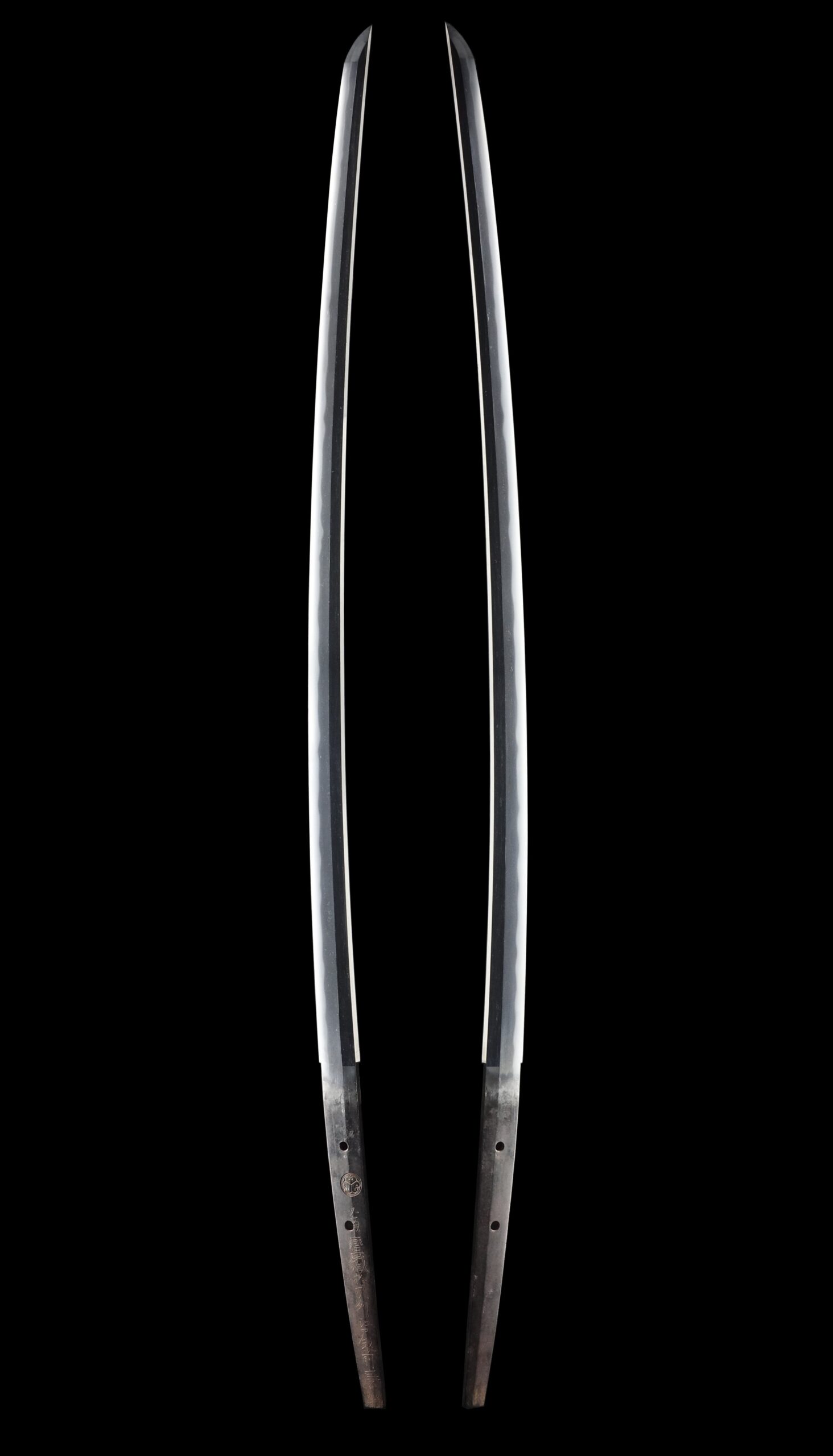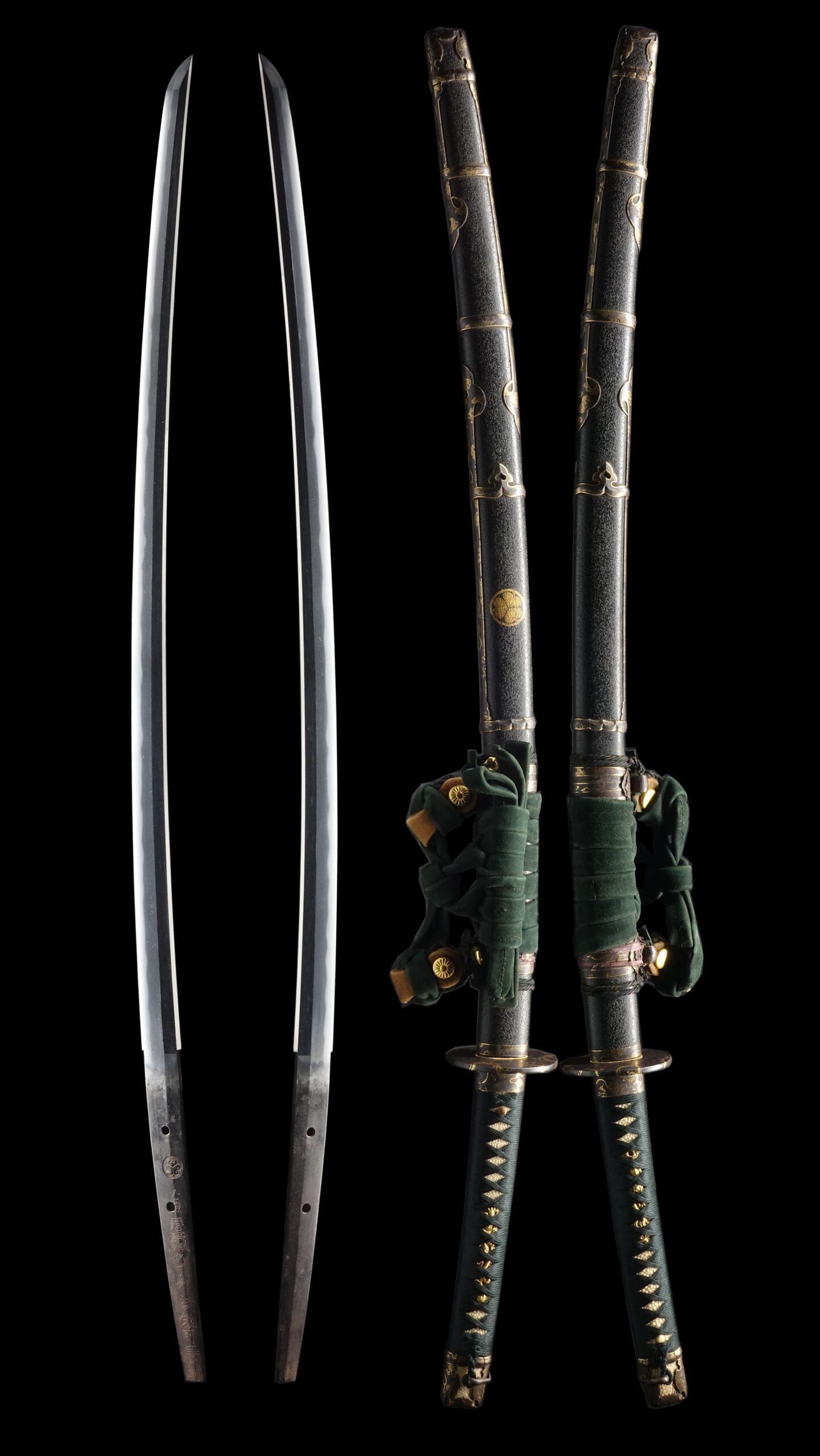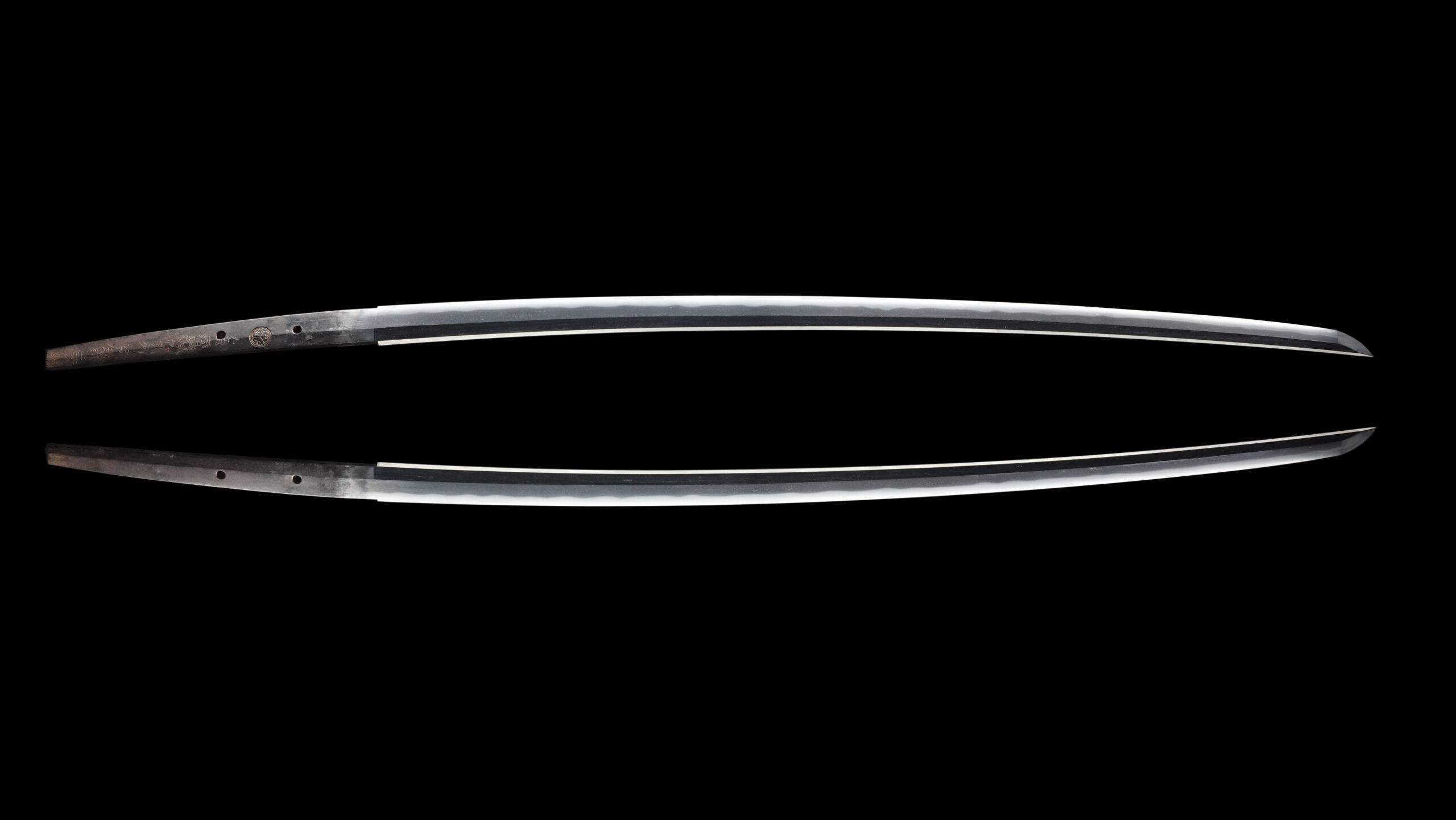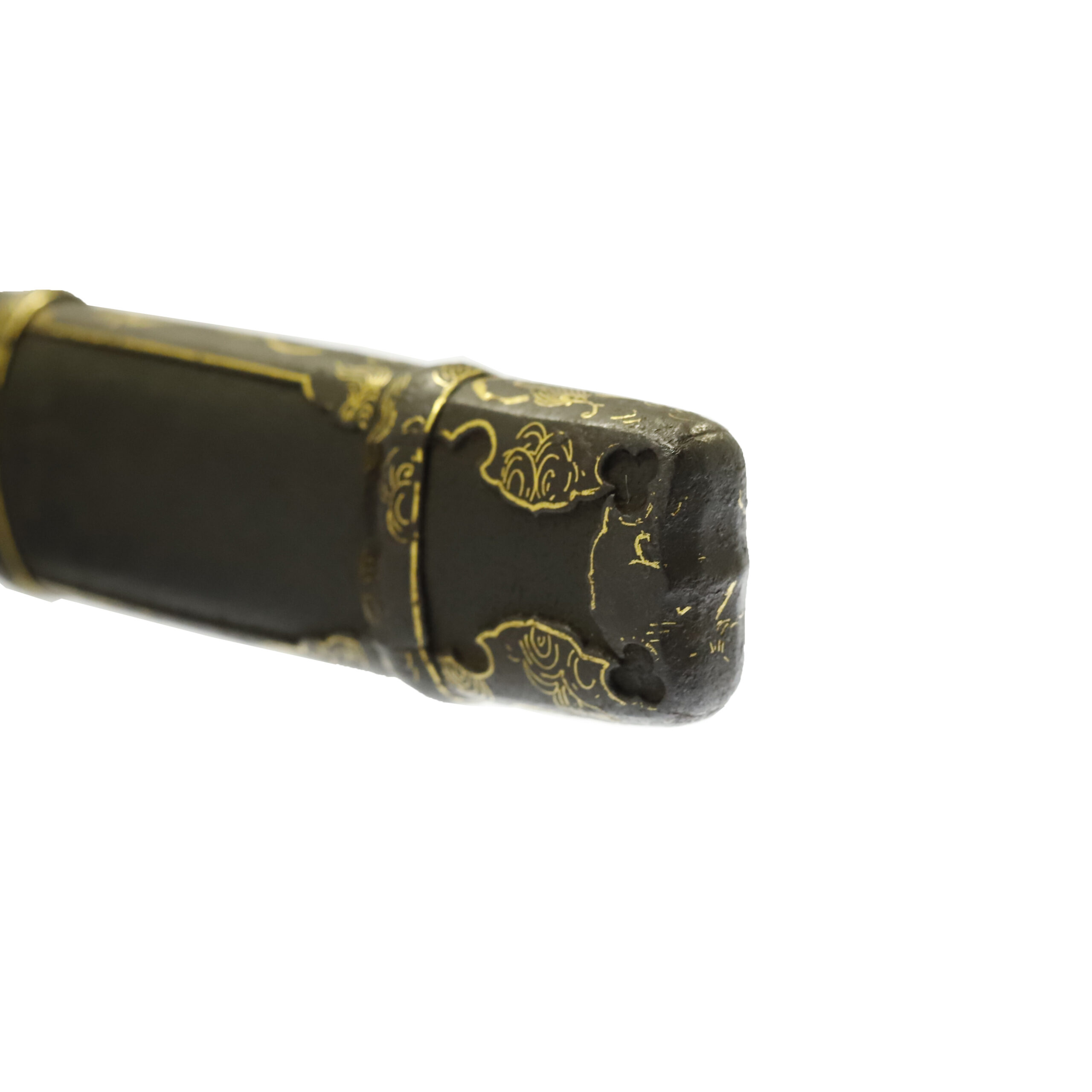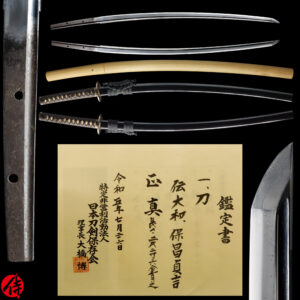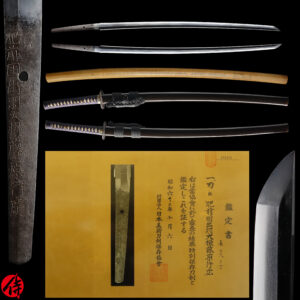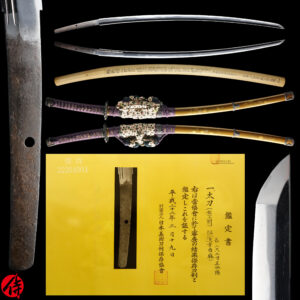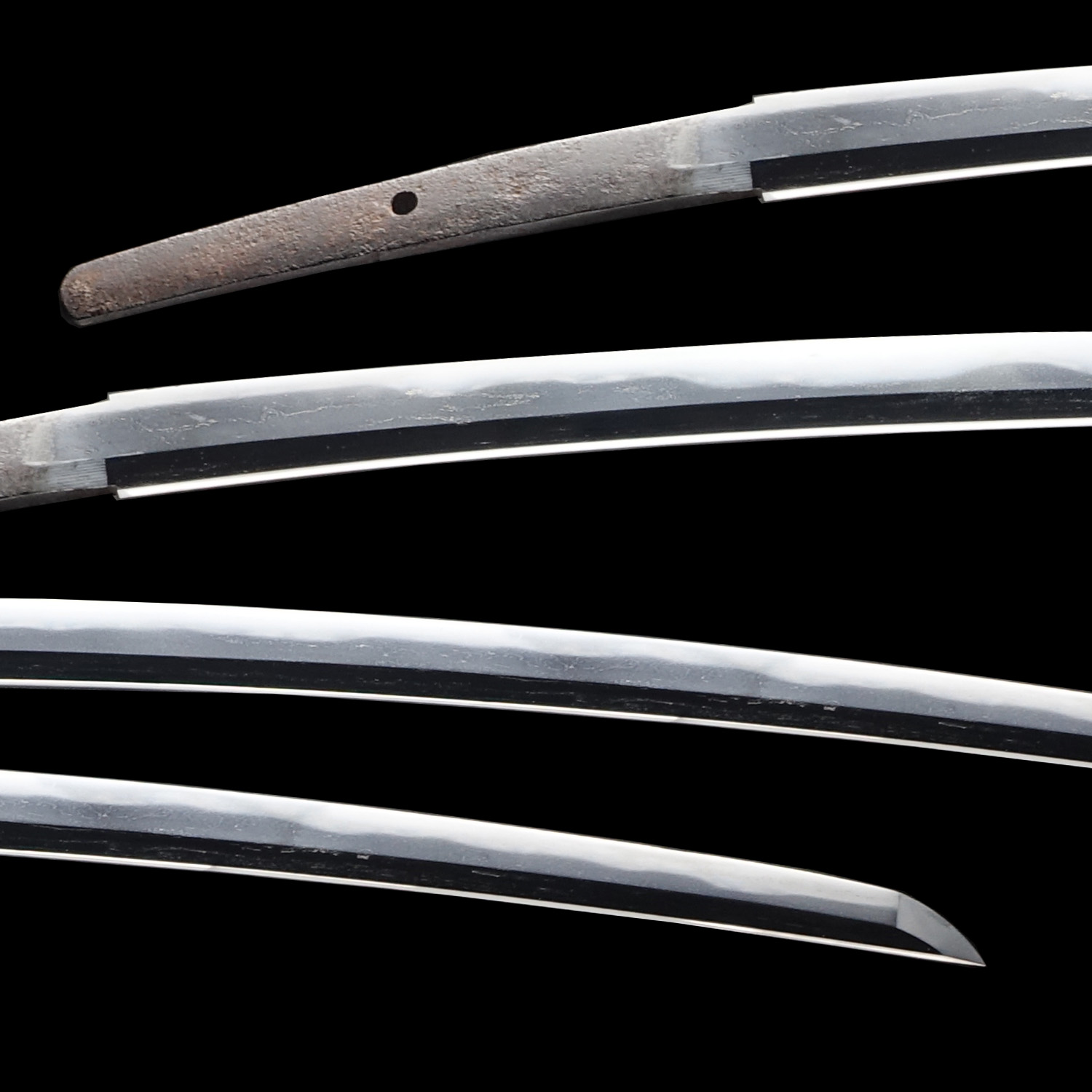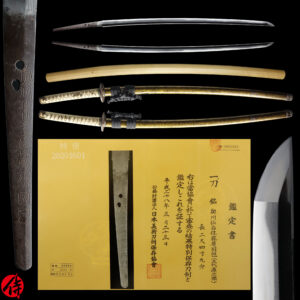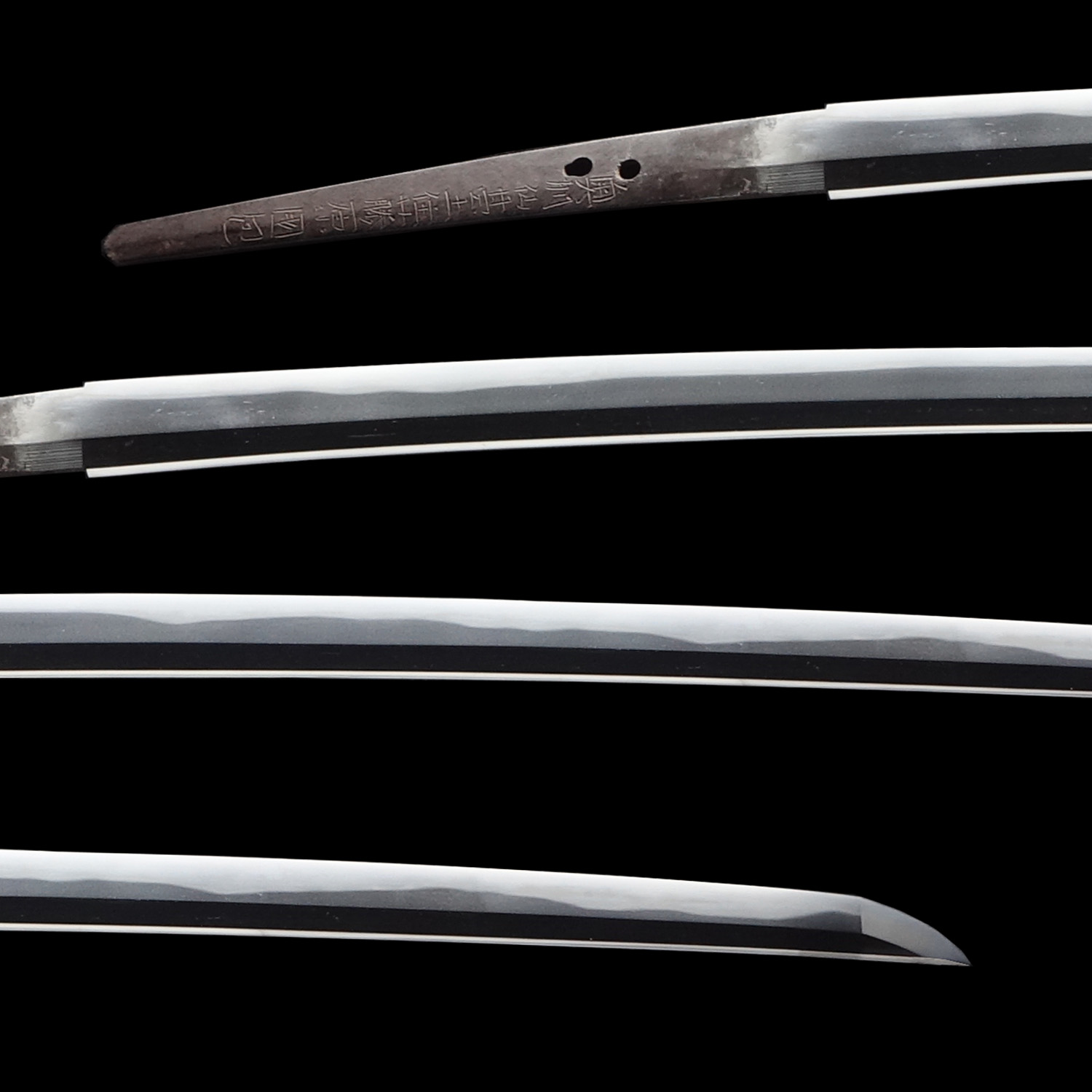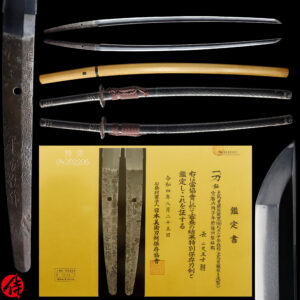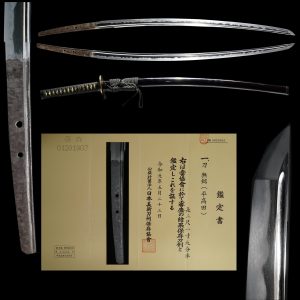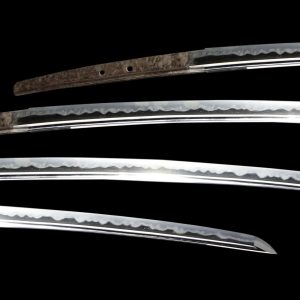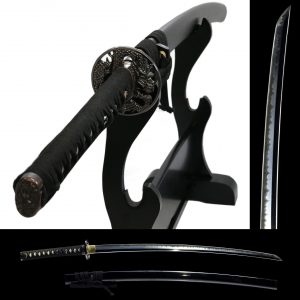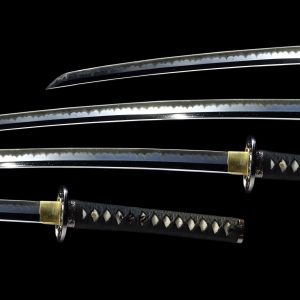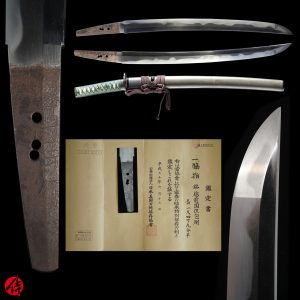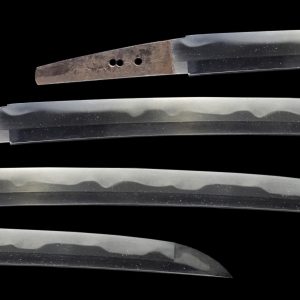Antique Japanese Sword Katana Katana signed by Edo Echizen Yasutsugu with NTHK Kanteisho
【Description】
Summary
This blade was signed by Bushu Edo Echizen Yasutsugu (武州江戸越前康継) during the Kanei era (1624-1644: Early Edo period). This Yasutsugu is the second-gen Yasutsugu, the first son of the first-gen Echizen Yasutsugu. The signature also says this blade was made of western carbon steel called Nanban Tetsu (南蛮鉄) with general Tamahagane. Foreign carbon steel was costly back then, and either the swordsmith or the person who ordered it wanted to be proud of the social status by inscribing this fact. Also, you can see AOI Mon, the holly oak symbol. This symbol is only allowed for the swordsmiths who exclusively served Tokugawa Shogunate during the Edo period. The maker’s name, Yasutsugu, lasted twelve generations, and the first and second generations are the most acknowledged swordsmiths among them. Based on the signature of this blade, it was made in Edo (Today’s Tokyo).
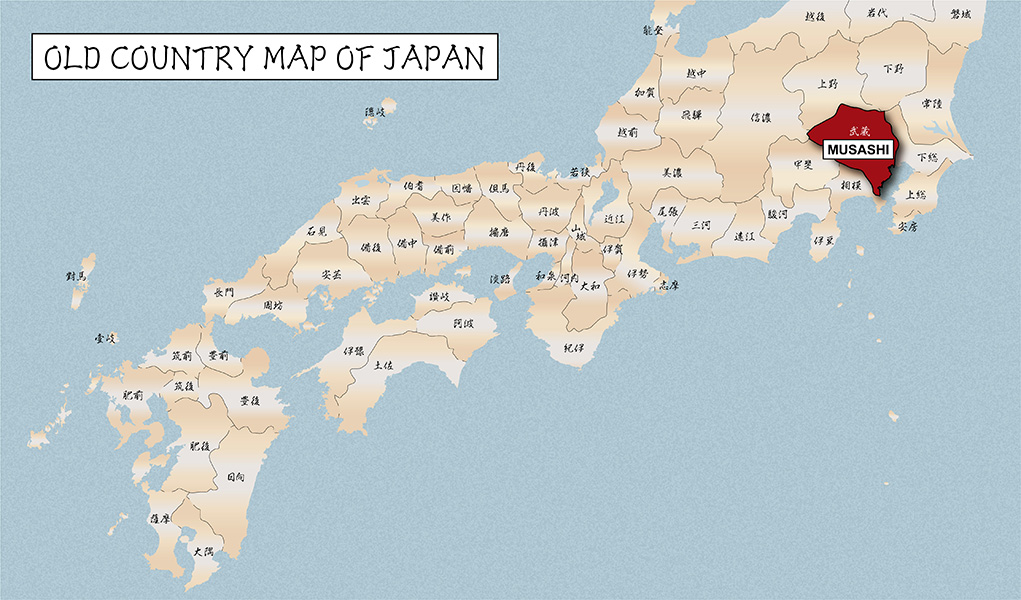
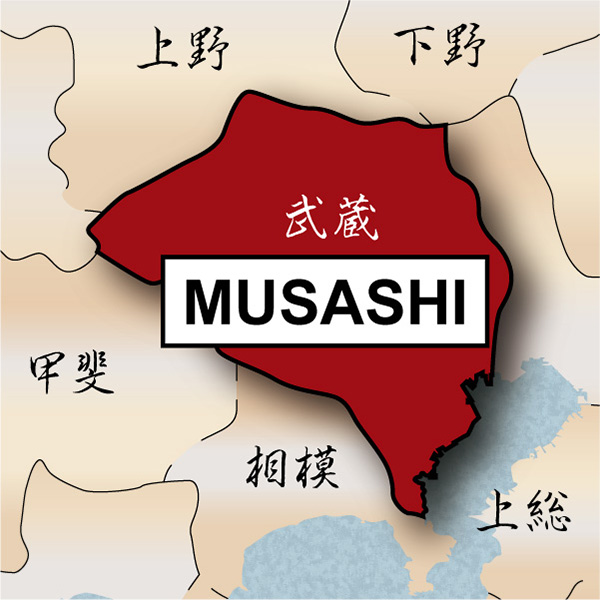
The second-gen Yasutsugu initially signed Yasutsugu (康次). As you can see, the Kanji letter of Tsugu (次) is different from his later name Tsugu (継). His birthname was Shimosaka Ichinojo. We would like to explain who the first-gen Yasutsugu was before describing the second-gen.
It is said that his father, the first-gen Yasutsugu, was the founder of the Echizen Shimoasaka school. The first-gen Yasutsugu was born in Shimosaka town in Shiga prefecture at the end of the Muromachi period(Late 16 century ). He built his career there until the beginning of the Keicho era(1596). However, he moved to Echizen province due to the relocation of the lord he served. He eventually was noticed and supported by Matsudaira Hideyasu, the third son of Tokugawa Ieyasu, who founded the Edo government. Hideysu was the feudal lord of Echizen province during the early Edo period. With the support of Hideyasu, the first-gen Yasutsugu was able to establish the Echizen Shimosaka school. And his school’s fame became nationwide.
By Hideyasu’s recommendation, the first-gen Yasutsugu became an Okakaekaji for the Tokugawa shogun family, meaning that he exclusively forged swords for the Shogun family. The first and second Tokugawa Shoguns, Tokugawa Ieyasu, and Tokugawa Hidetada acknowledged the first-gen Yasutsu’s craftsmanship, too. The first-gen Yasutsugu received 康(YASU) from Tokugawa Ieyasu in the 11th year of the Keicho era (1606) and changed his maker’s name. He was also allowed to inscribe the holly oak symbol(family crest of Tokugawa) on the tang. The school flourished during the Edo period and trained many skilled apprentices, such as the second-gen Yasutsugu.
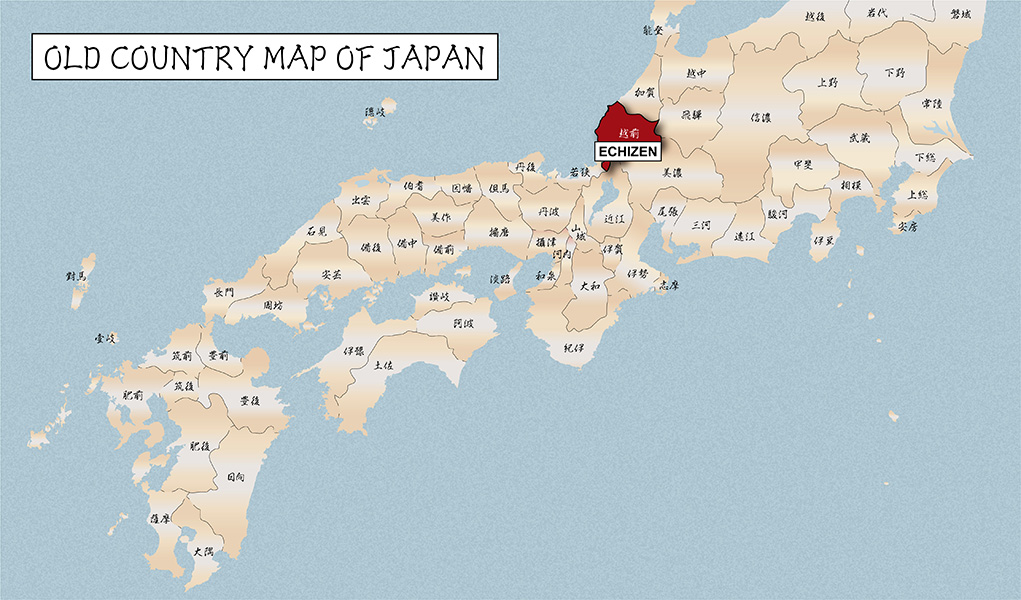
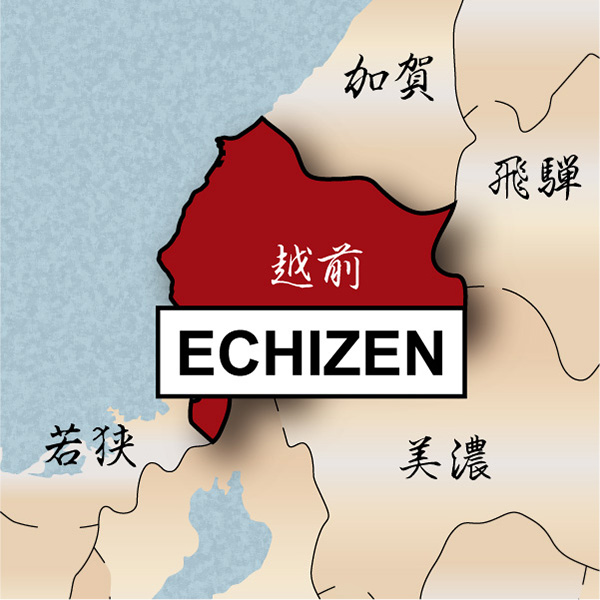
After the first-gen was deceased in the 7th year of the Genna era (1621), the second-gen took over his father’s position. The second generation was ordered by Tokugawa Hidetada, the second Shogun, to live in Edo city, forging blades. Tokugawa Hidetada had faith in the second-gen Yasutsugu. It is said that the second-gen Yasutsugu worked very closely with the Shogun and was accompanied at the Shogun’s important events, such as hunting with a falcon. The second Yasutsugu lived in both Echizen and Edo, going back and forth every other year. However, in 1623, he settled in Edo City under the government’s order.
Later in his career, he became a Buddhist priest and changed his maker’s name to Yasuetsu (康悦) from the 13th-14th year of the Kan-Ei era (1636-1637). He died in the third year of the Seiho era (1646). After he died, there was a historically interesting dispute over who would take over the school. From the third generation, there were two Yasutsugu schools. One was located in Echizen, and the other was in Edo. You can check more details from here.
Tachi Koshirae
This blade is stored in Tachi(太刀) Koshirae. Tachi was mainly used by an armored Samurai with one hand on horseback from the Heian period (794-1185 A.D.) until the early Muromachi period. TACHI was suspended loosely on the left waist with its edge facing the ground so that you could draw it faster to cut down soldiers on the ground. Because of its gorgeous looking, having a Tachi-style sword mounting became a social status among Samurai.
【 Blade】
Cutting Edge Length(Nagasa): 75.3 cm ( 29.6 inches)
Curvature(Sori):1.6 cm (0.63 inches)


Hamon:
The crystalline structure which forms along the cutting edge of a blade as a result of the hardening process
Jimon(Jihada):
visible steel surface pattern created by folding and hammering during forging process
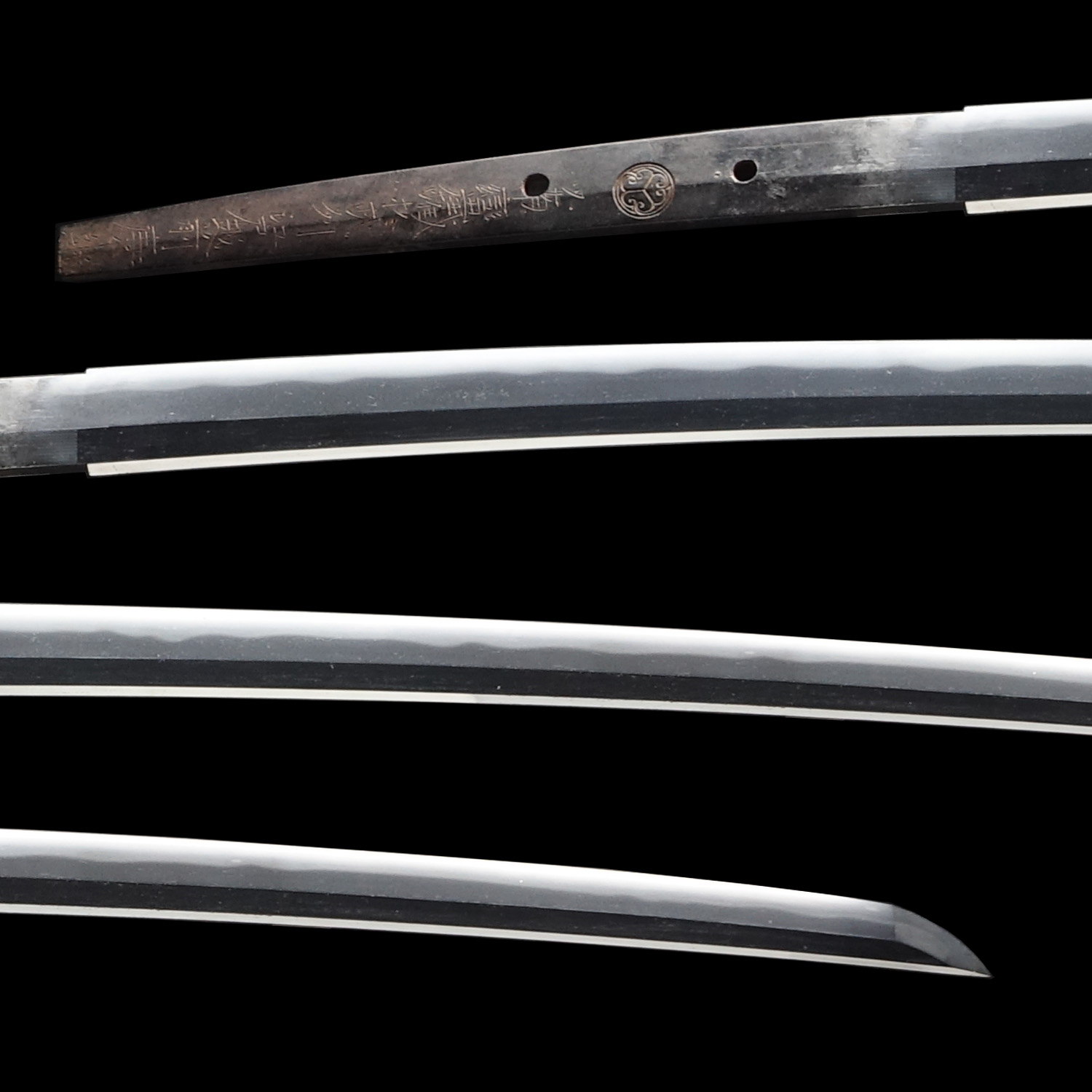
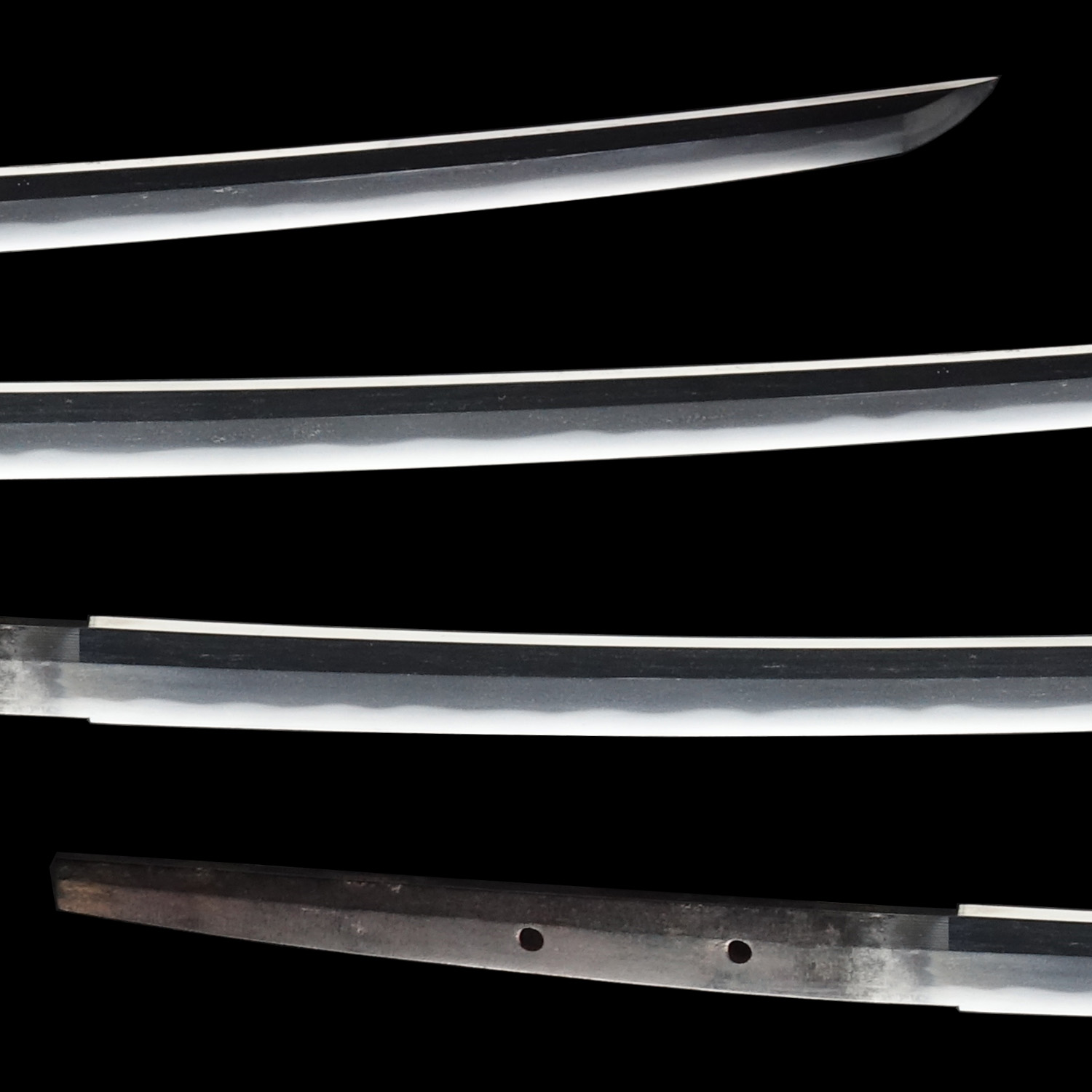
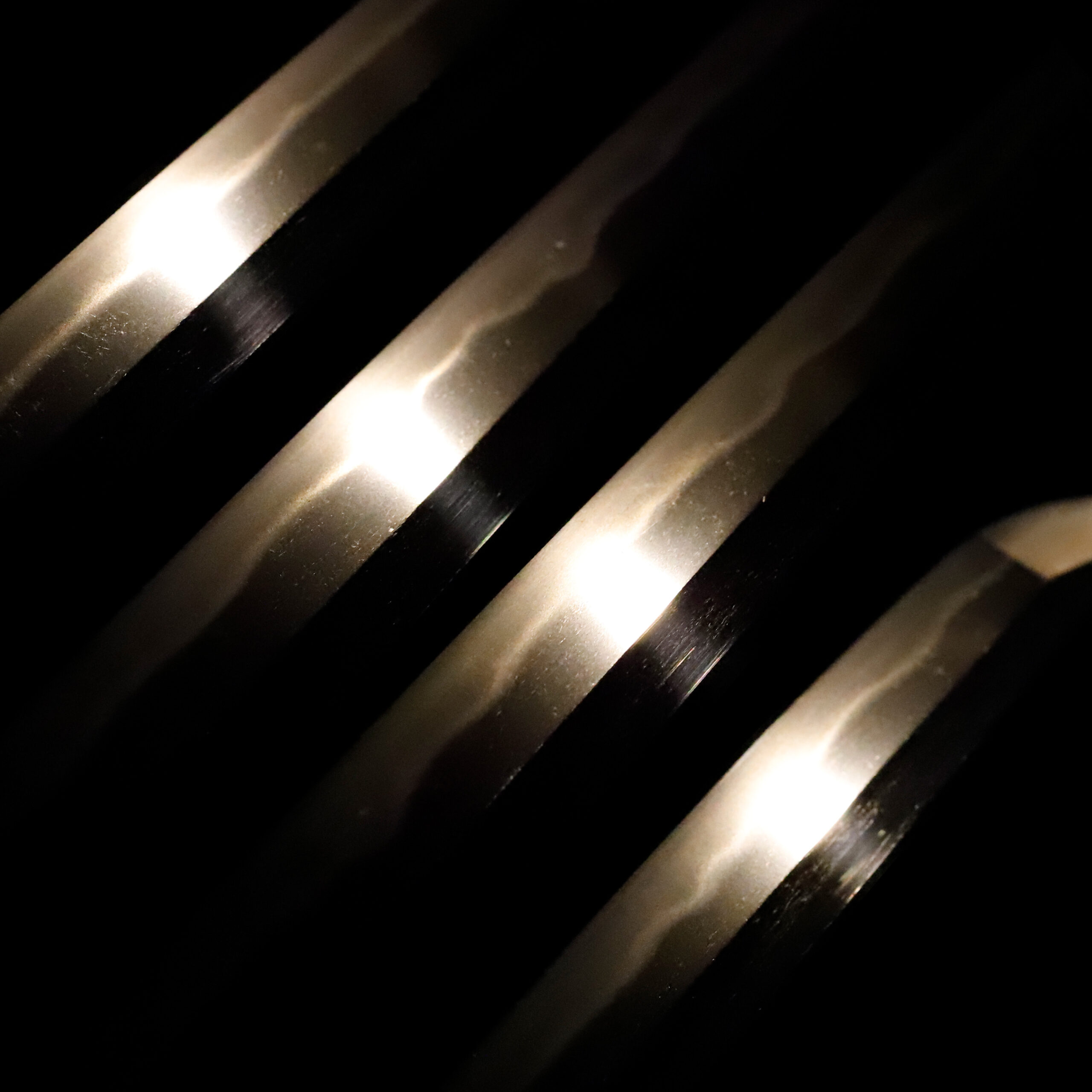
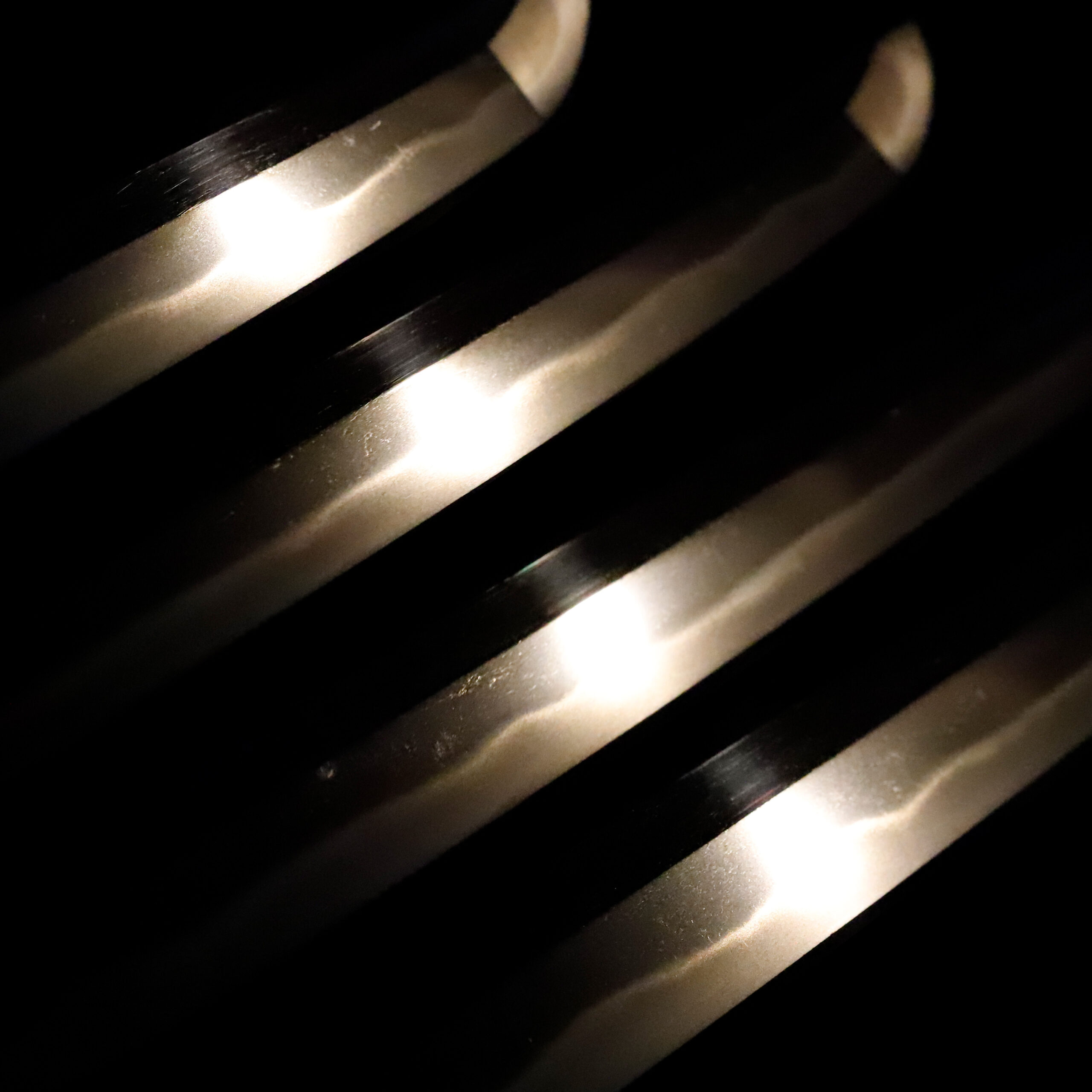
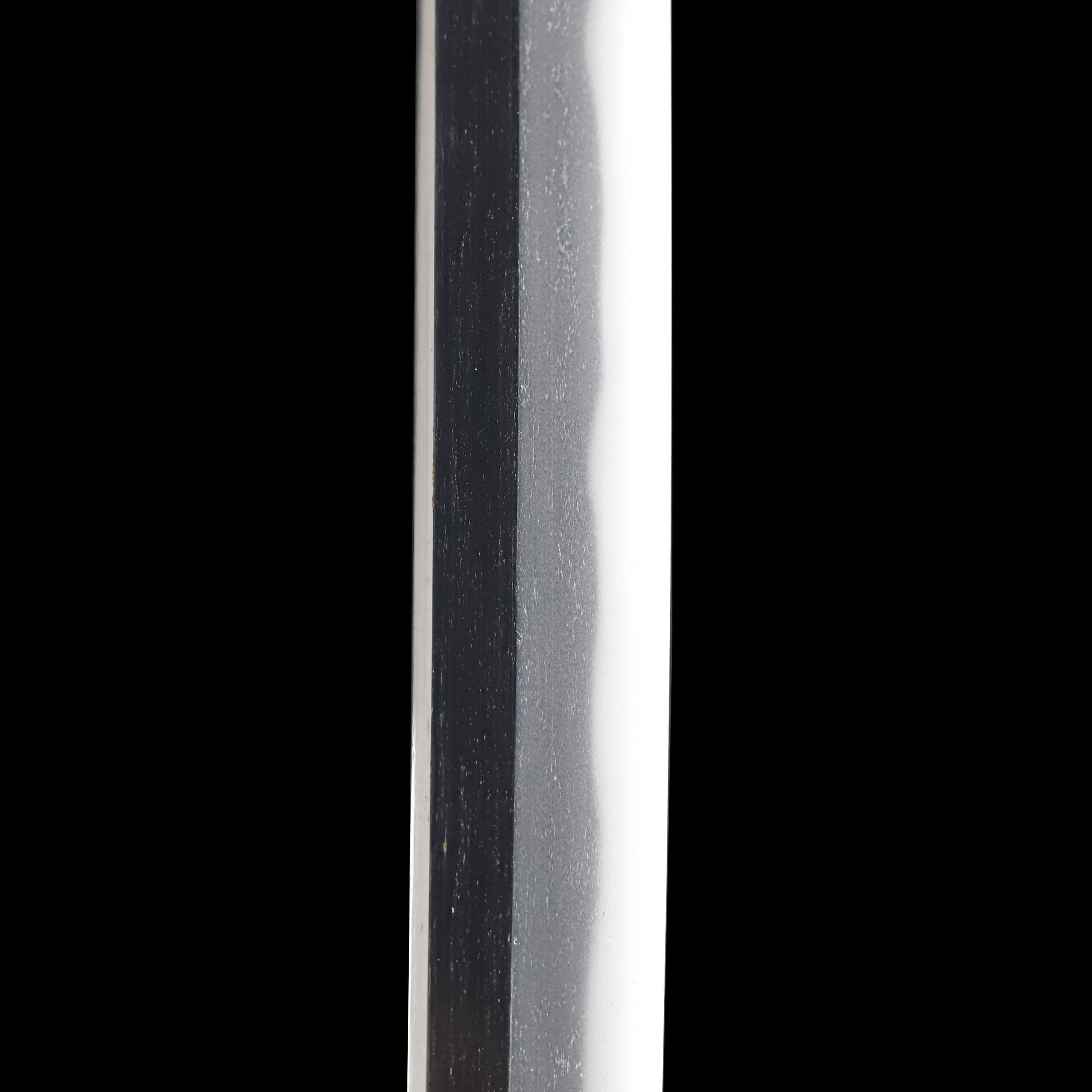
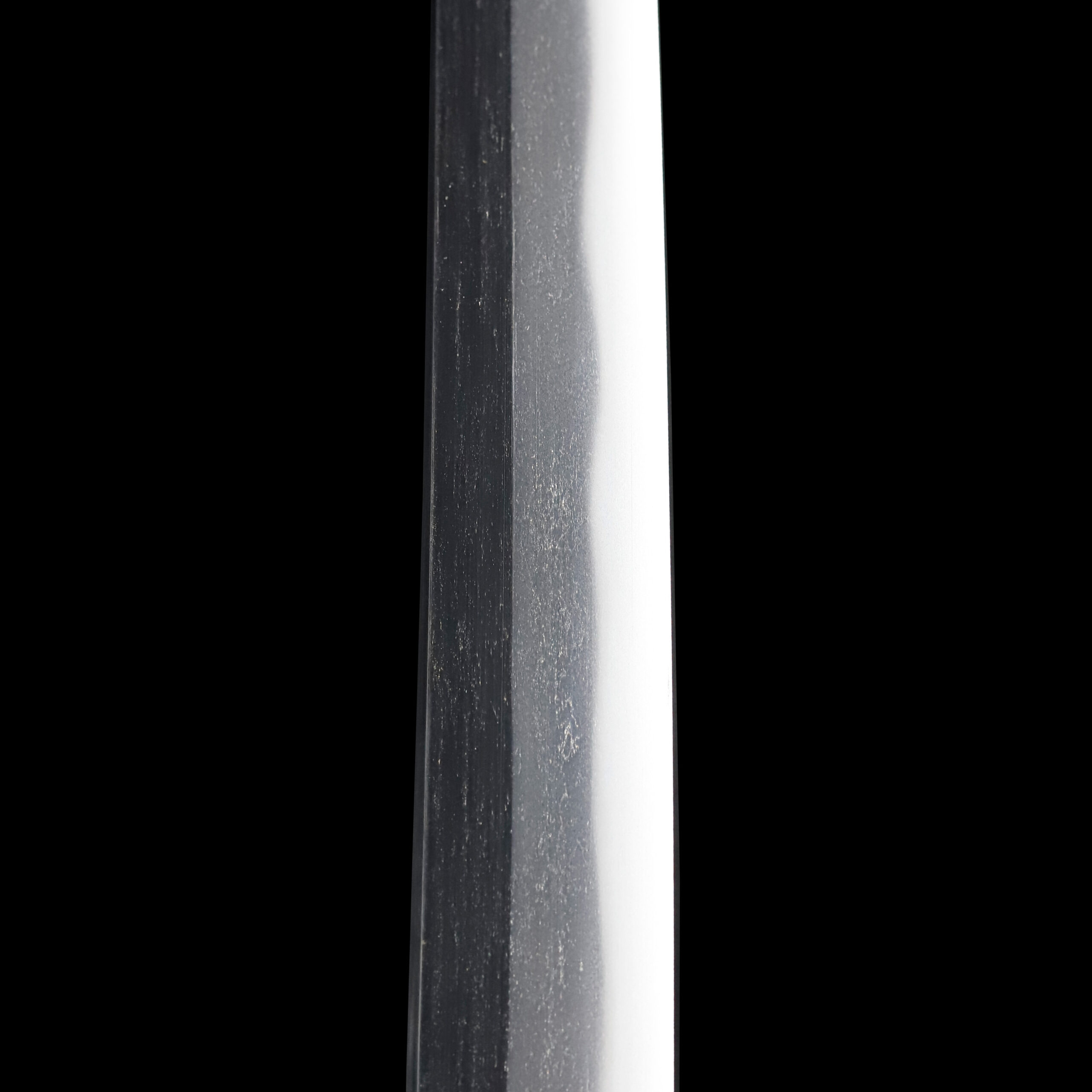
Nakago:Nakago is the tang of the Japanese sword.
Japanese swordsmiths left the black rust on the tang because it prevents red rust while the tang is in its handle. And the discoloration of the tang was created over time, and it is a great indicator for a Japanese sword specialist to estimate when the sword was forged.
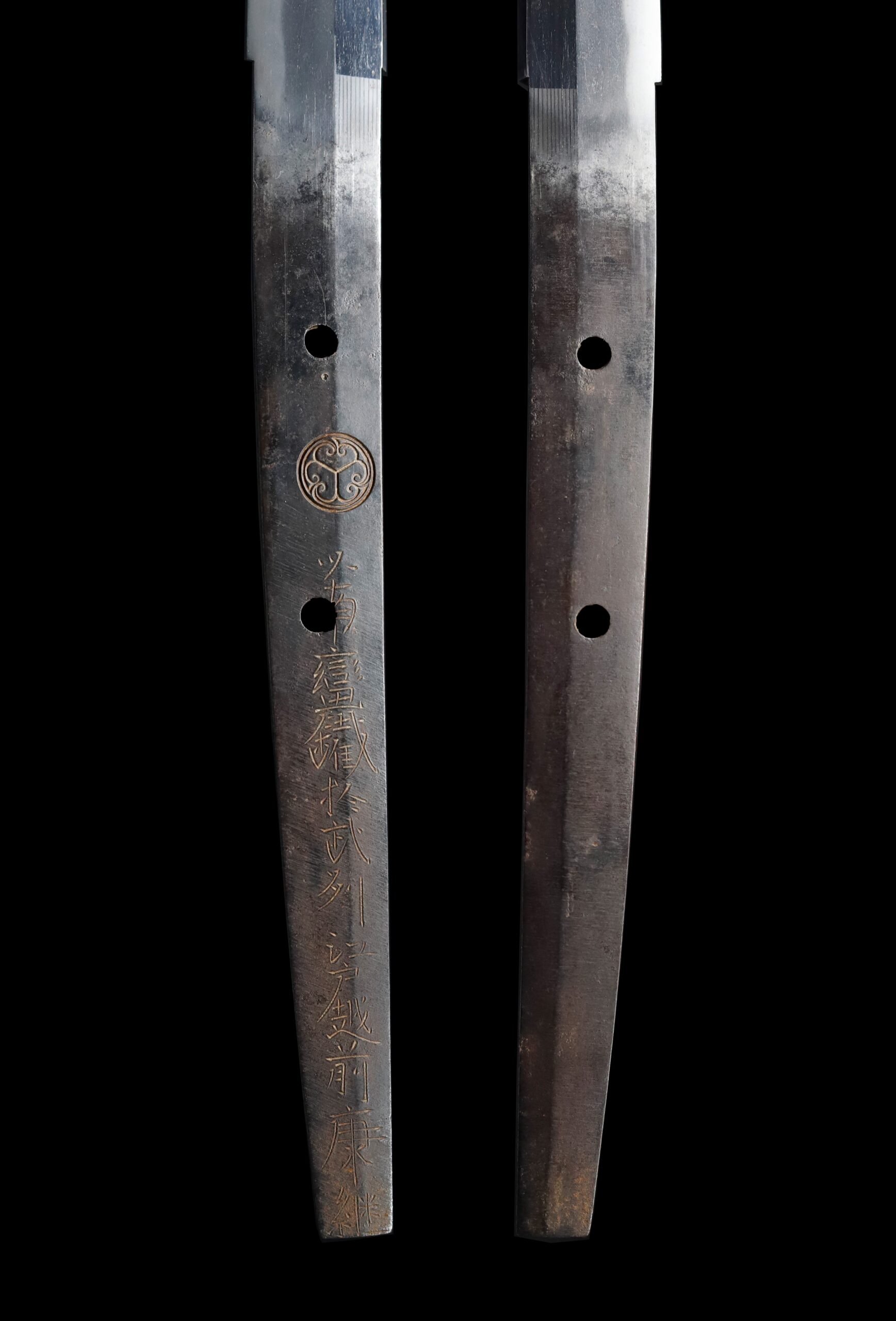
Koshirae: Koshirae is the mounting of the Japanese sword. There are several parts that consist of Koshirae such as Saya(Scabbard), Tsuka(Handle), Tsuba(Handguard).
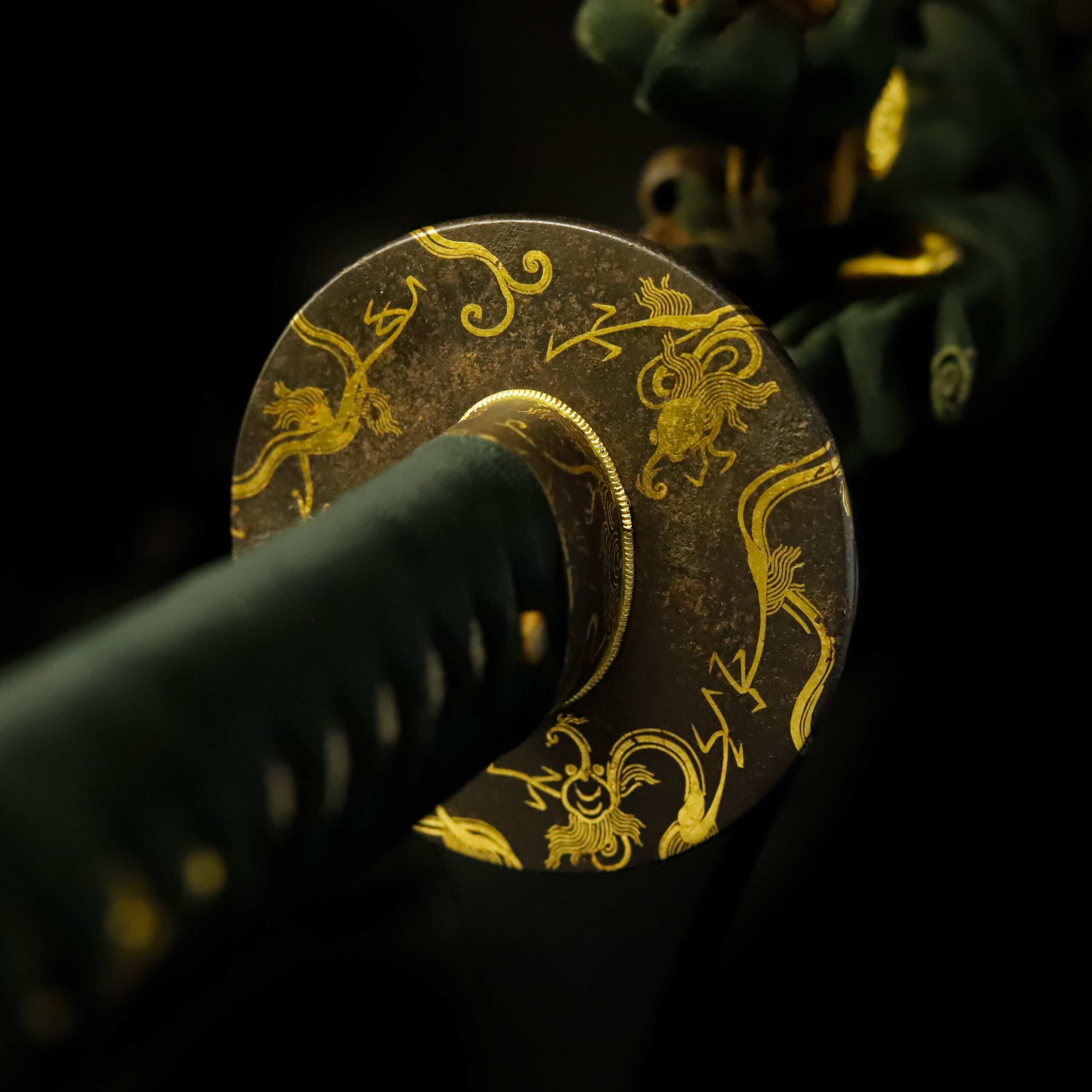
Fuchi-Kashira:A pair of matching sword fittings that cover the upper and bottom parts of its sword hilt.
The Kabutogane (冑金/兜金) is a metal fitting that is attached to the end of a handle. And a Sarute/Sarude (猿手) is attached to this Kabutogane. The user of a sword passed the Udenukio (腕貫緒, a cord wrapped around the wrist to prevent a sword from falling out of the hand, mainly used when riding a horse) through this ring. In addition, the Fuchi Kanamono (縁金物) is also a metal fitting attached to the handle, but on the opposite side of Kabutogane.
All these metal parts, including the scabbard, were designed with the same style. You could see the depiction of dragons and cloud patterns are inlaid with brass on the following metal fittings: The Kuchi Kanamono (口金物, a metal fitting that is attached to the tip of the scabbard close to Tsuba), Seme Kanamono (責金物, a ring-shaped metal fitting placed in the middle of the scabbard to prevent the sheath from cracking), Ashi Kanamono (足金物, metal fittings attached to the positions where Sageo cord is wrapped), and Ishiduki Kanamono (石突金物, a metal fitting that is attached to the end of the scabbard).
The dragon is the common motif throughout the entire design of this Tachi Koshirae. You would find multiple dragons here and there. In particular, we think the theme Unryu Zu (雲竜図, a combination of dragons and clouds) is its subject. Initially, dragons were imaginary creatures found in ancient foreign traditions and myths. Furthermore, it is regarded as a symbolic beast of auspicious signs. Its body is likened to nine animals: antlers are deer, the head is a camel, eyes are demons, the neck is a snake, the belly is the Mizuchi (蛟, a mythical animal in Japan that looks like a snake and has a horn and four legs), scales are fish, claws are falcons, palms are tigers and ears are cows. It was thought that the dragon would reign at the top of all animals because of its odd-looking appearance.
About the cloud pattern, clouds bring blessed rain and snow, and their movements significantly affect the day’s weather. Due to its supernatural power, a theory says that gods, spirits, and dragons dwell in the clouds. In Japan, there is a belief that dragons are worshipped as water gods. Since rice cultivation has flourished in this country, people always treat water as an essential resource. We imagine many people wished for a plentiful harvest in the Unryu theme. From such a religious aspect, we could infer that dragon designs were familiar to people for a long time.
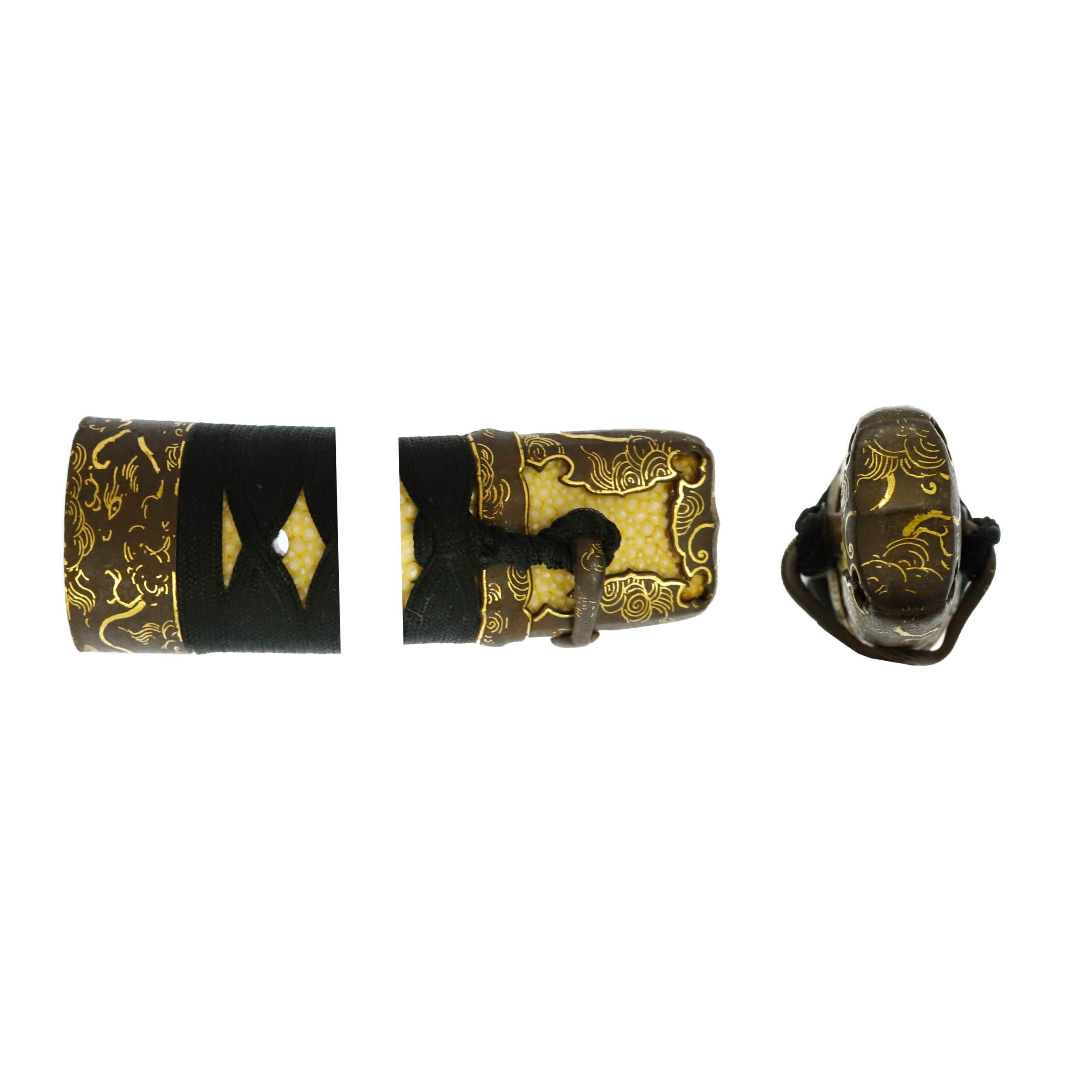
Tsuka and Menuki:Tsuka is the handle of the Japanese sword and Menuki is its decoration.
You would find the figure of a dragon on each side of the handle. Golden paint is applied to each dragon, and its bright color remains in good condition. Compared to other sword mountings of this Koshirae, dragons designed for Menukis are relatively depicted in realistic touch. When dragons are designed for Menukis, we often find that dragons have a ball-shaped object in their hand. While we cannot see it on this work, probably due to the Tsukamaki thread, we would like to mention it here. This item is called the Nyoi Houju (如意宝珠, Cintāmaṇi), a fantasy jewel that fulfills any desire and gives out treasure, clothes, food, and drinks. Moreover, it heals illness and suffering, removes evils, purifies muddy water, and prevents disasters. It is said this magical item is taken from the brain of the dragon king.
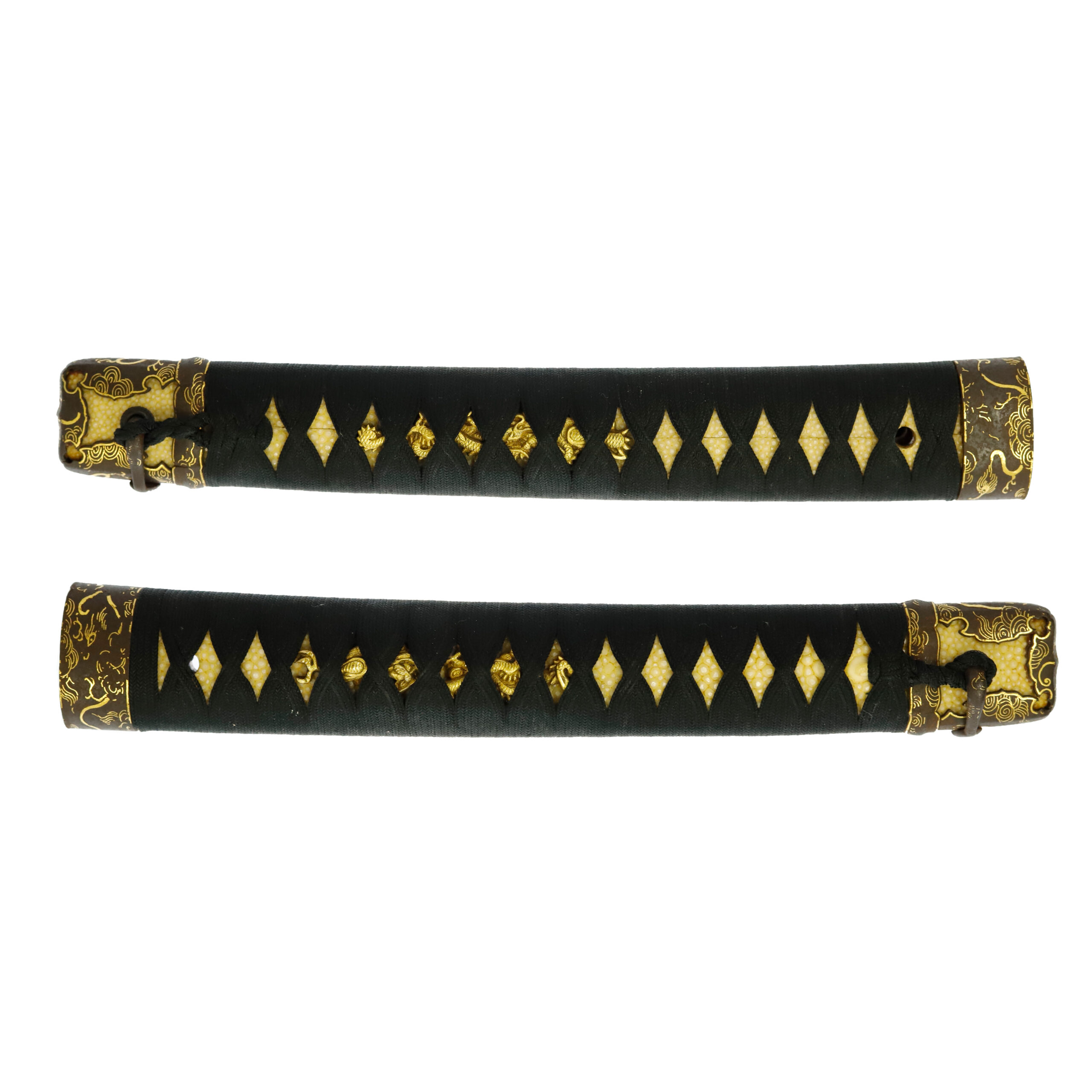
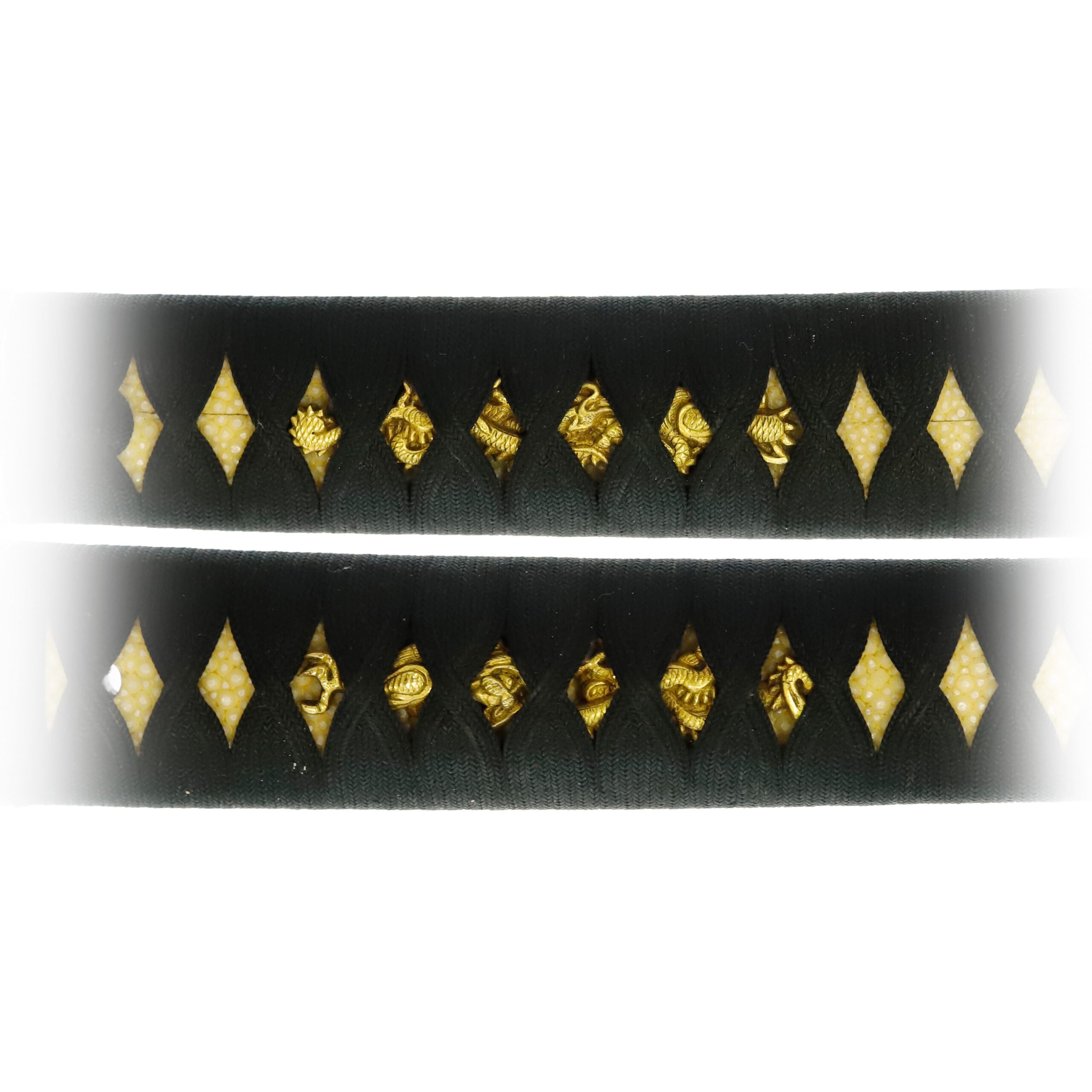
Tsuba and Habaki:Tsuba is the handguard for the Japanese Sword and Habaki is the equipment to make the blade not touch its scabbard inside. It prevents the blade from getting rusty and chipped.
This Tsuba seems to be made from iron. The dragons designed here are depicted with expressions of quite similar style to the metal fittings of the handle. As this work is incorporated into a part of the Tachi Koshirae, the top and bottom of the Tsuba are reversed, so its design appears to be upside down. We assume that multiple dragons are depicted with brass inlays. The heads of the dragons are mainly depicted on the front of this Tsuba, and the dragons’ bodies, primarily the tails, are shown on the backside of this Tsuba.
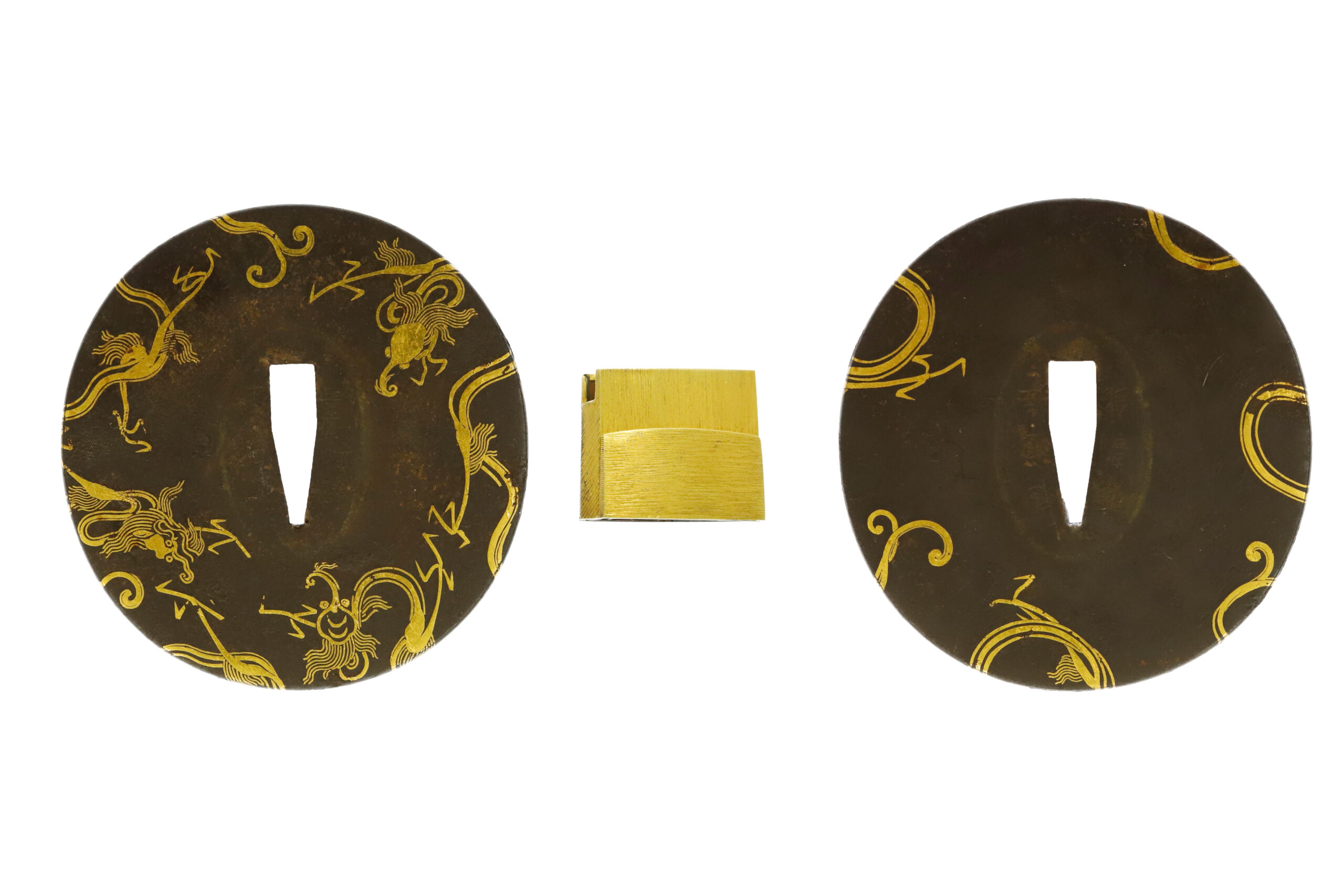
Saya: Saya is the scabbard for the Japanese sword.
One of the most famous family crests is designed on this scabbard. This mark is called the Aoi-Domoe / Mitsuba-Aoi-no Mon (葵巴/三つ葉葵の紋). It is a plant pattern in which each stem branches and has characteristic heart-shaped leaves. Today, it is known as the family crest of the Tokugawa Shogunate family led by Tokugawa Ieyasu (徳川 家康, 1543-1616), a famous military commander of the Warring States period. This plant pattern has also been used for the crest of the Kamo (加茂) shrine in Kyoto (京都) prefecture. The famous Shogunate family, the Tokugawa family, had their family crest with three leaves of Aoi (葵) due to their relationship with the Kamo shrine. As its leaves have a habit of always facing the sun, and the word “Aoi” is taken as “Aogu (仰ぐ, looking up)” for the sun, people thought the Aoi pattern would bring good fortune.
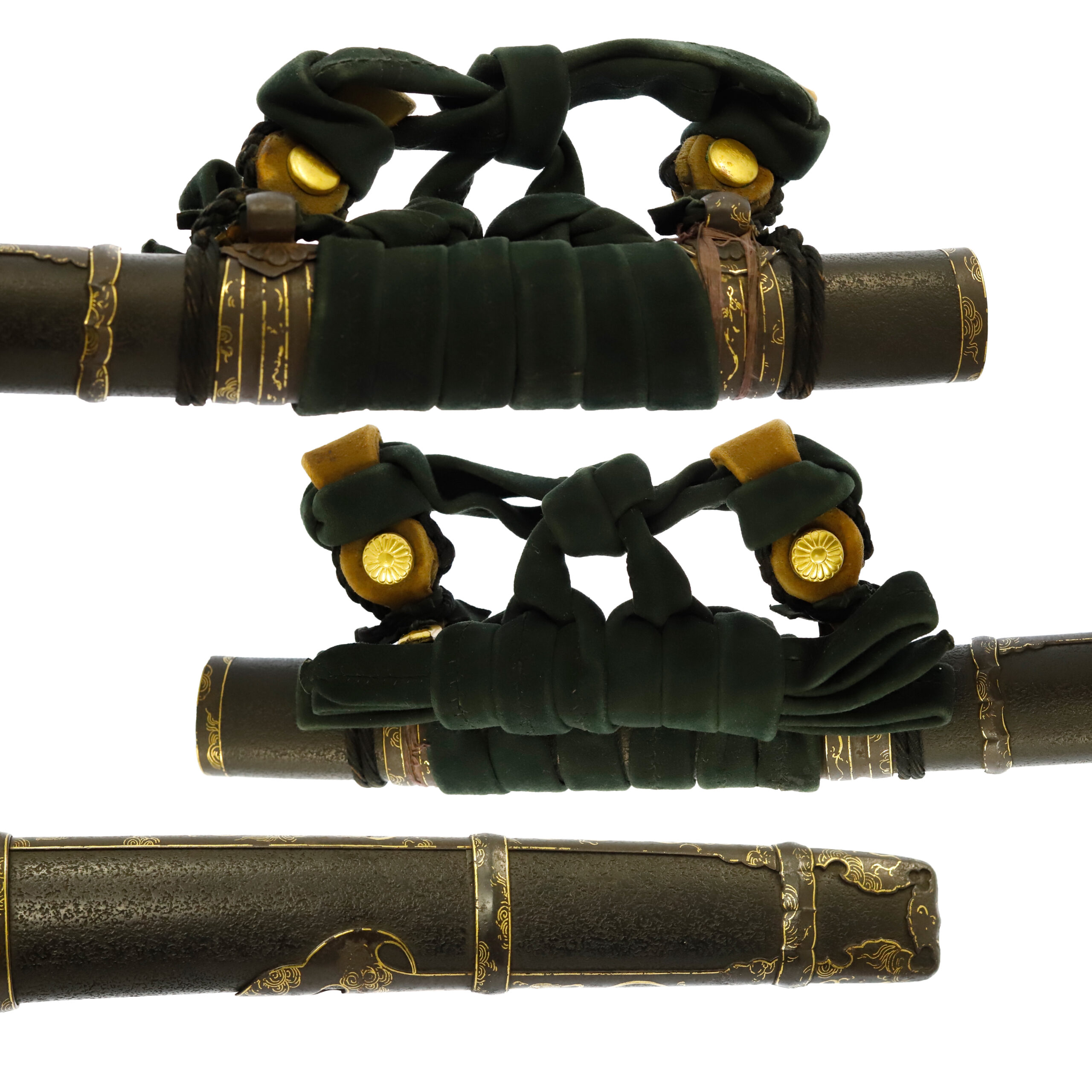
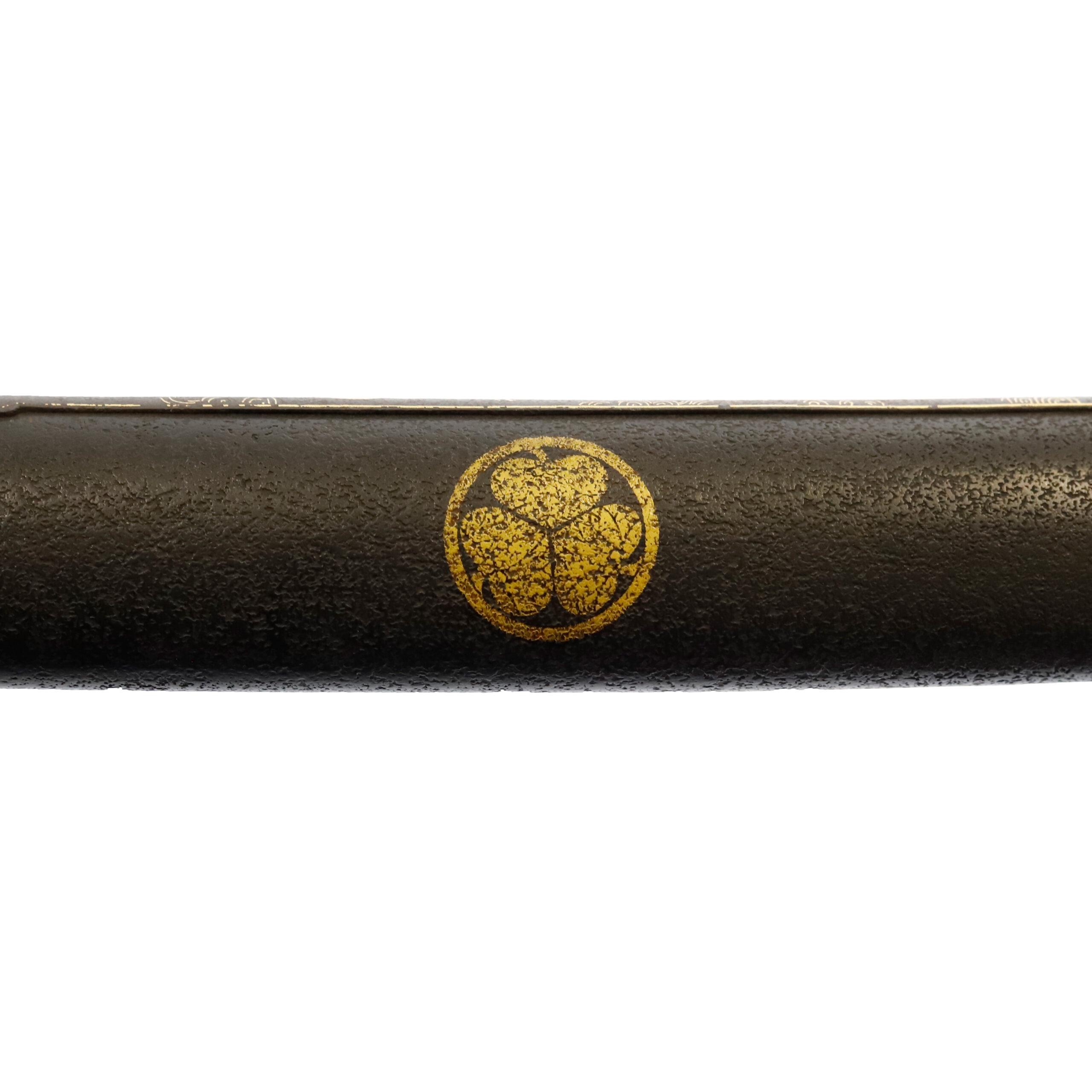
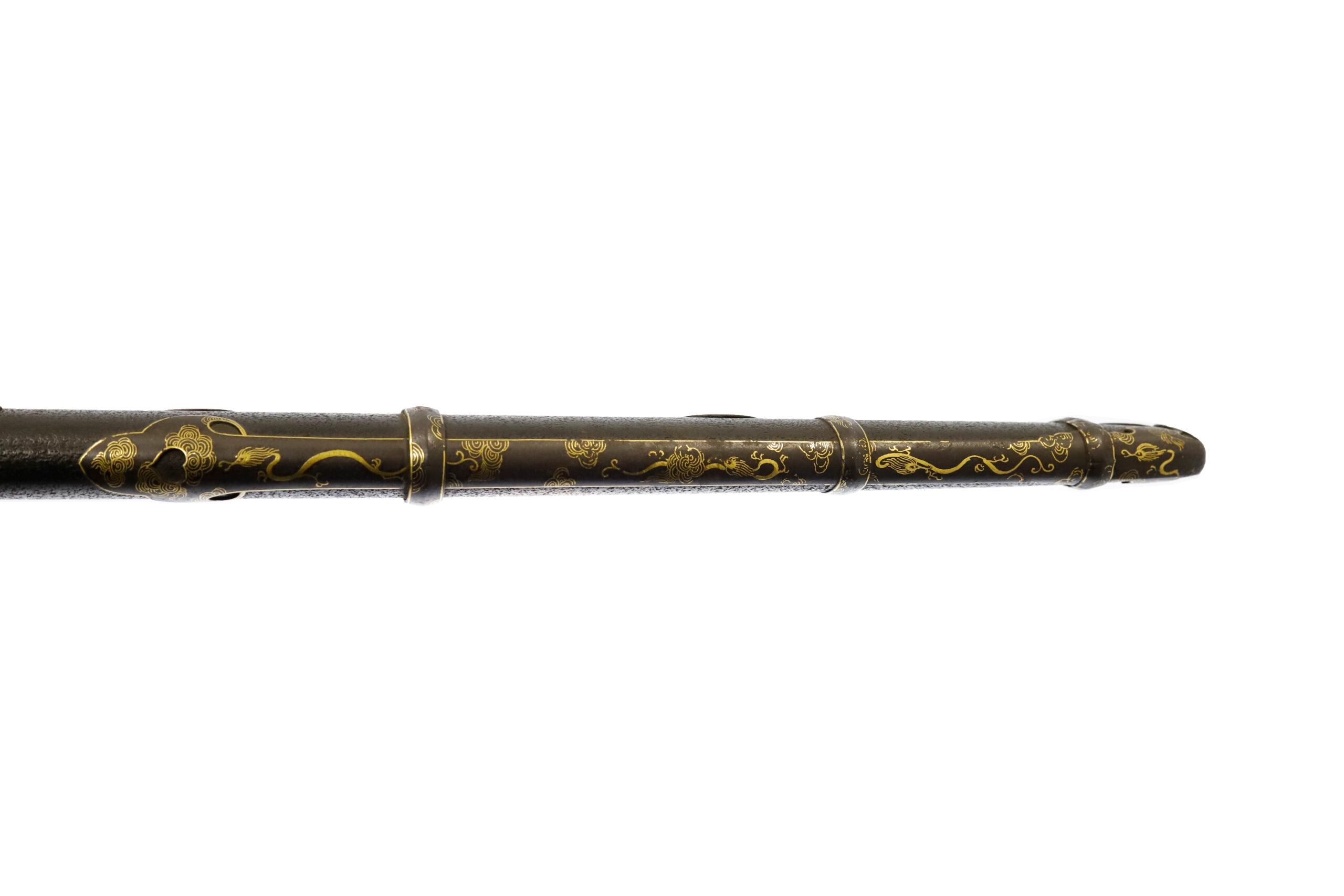
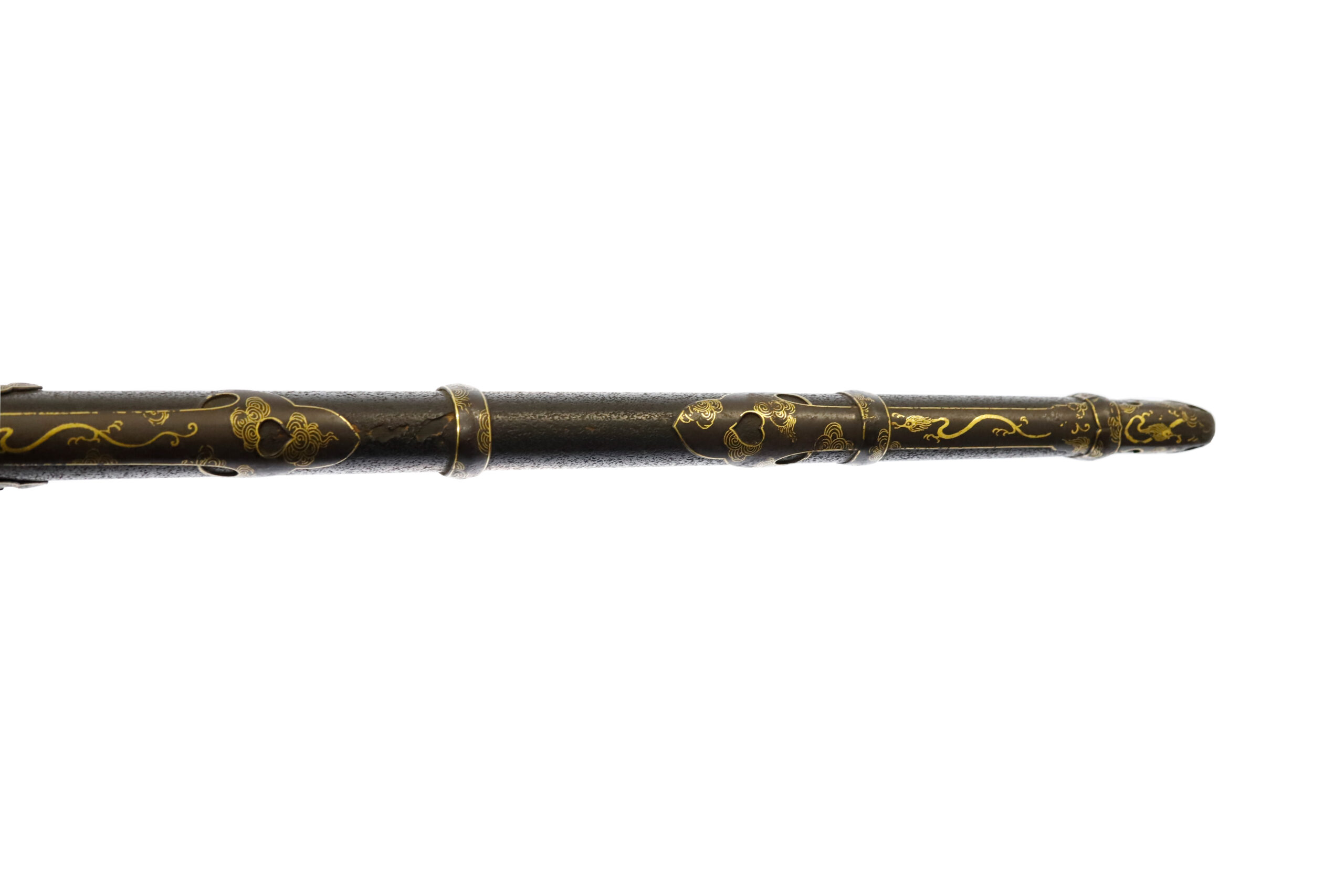
Authentication Paper:NTHK Kanteisho Certificate for the blade
NTHK, also known as NPO Nihon Touken Hozon Kai, is the oldest organization for sword authentication of Japanese swords in modern times. It was established in 1889 during the post-Samurai era. They authenticated the blade on Nov 12th in the 18th year of Heisei (2006). The purchaser will receive this original certificate as well. We can also translate what is written into English and make a PDF file for your record if you request.
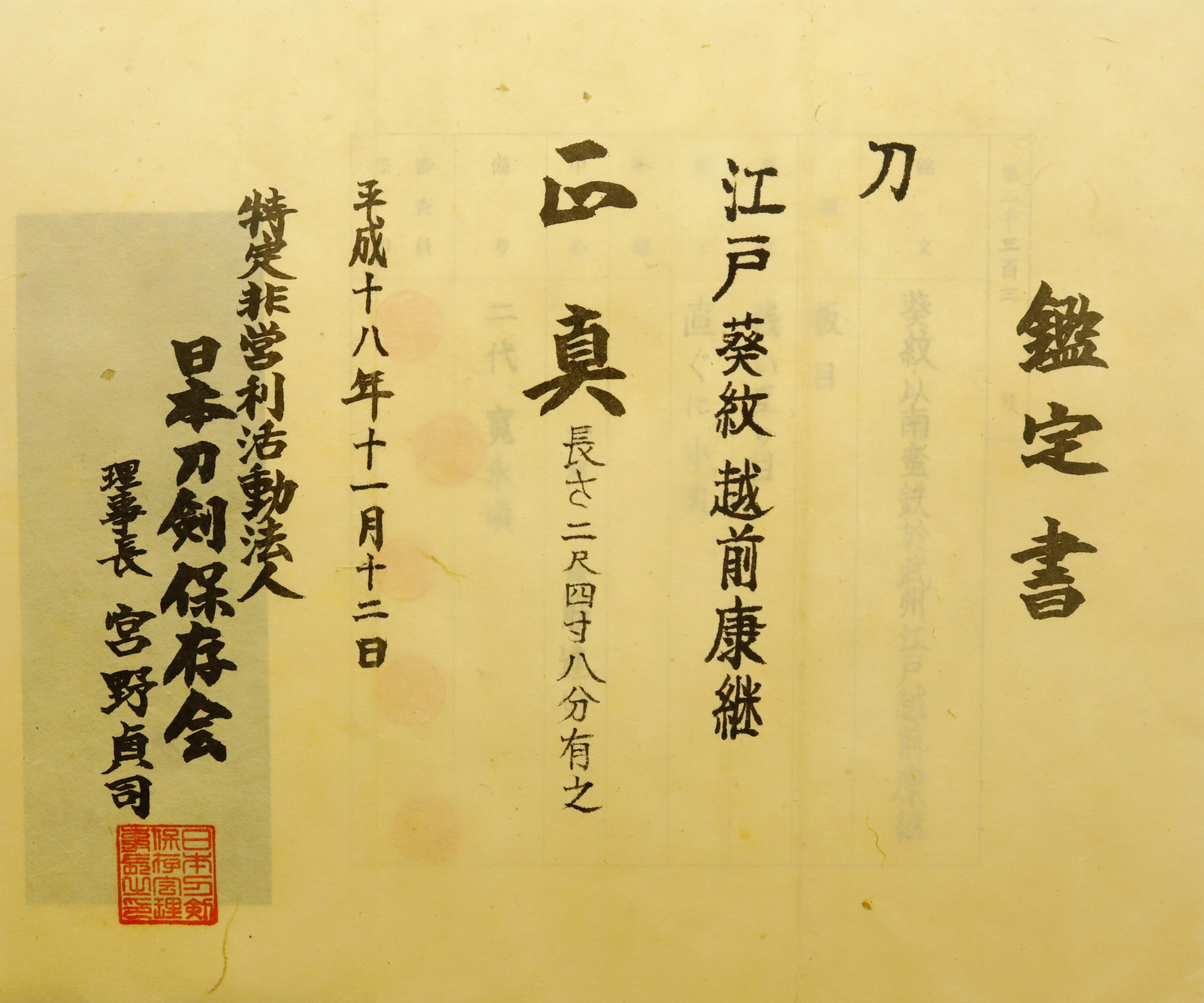
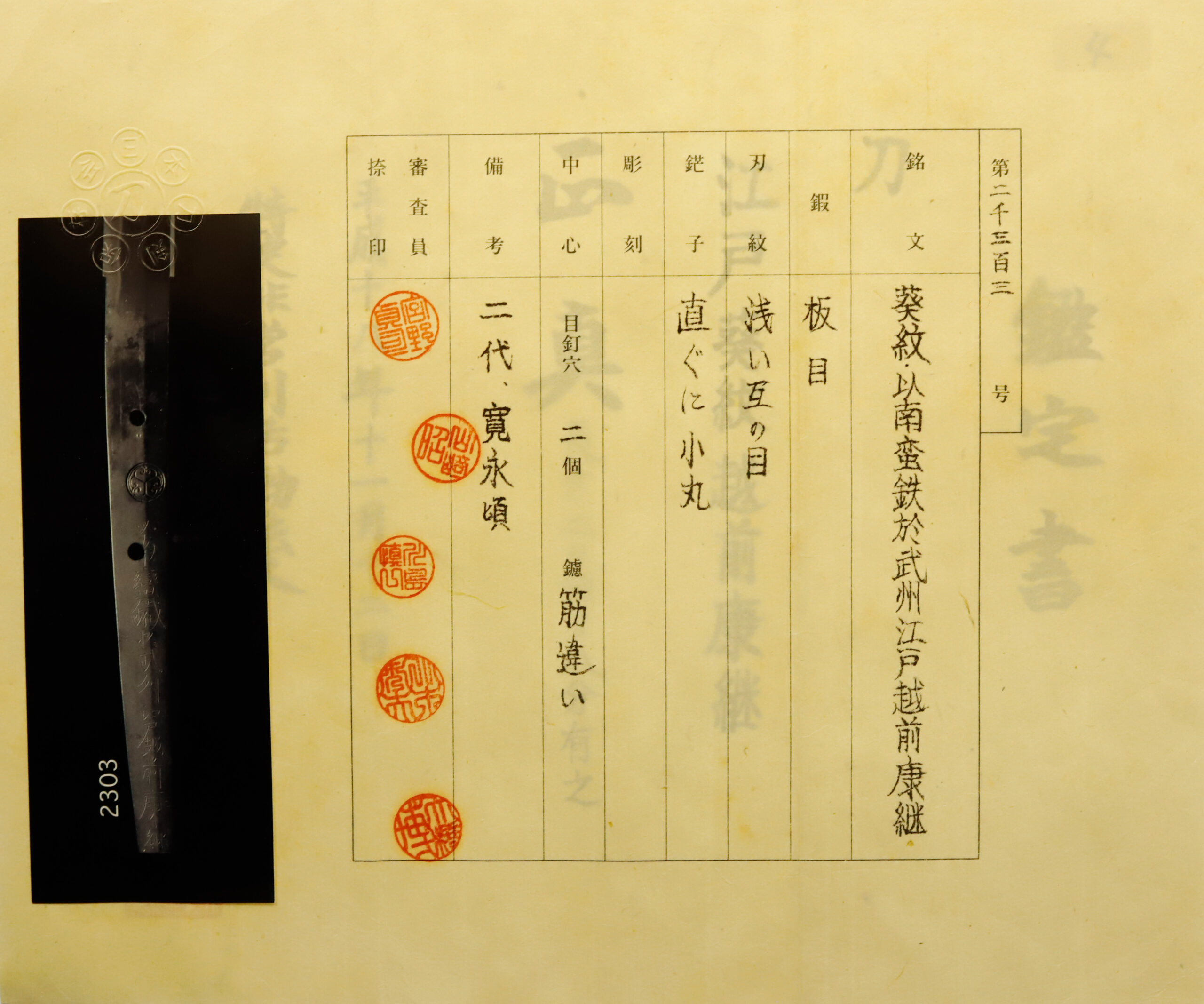
Registration Number : Tokyo 327143
The Board of Education in Tokyo prefecture issued a registration paper for this sword . It is called Jyu Token Rui Torokusho(銃刀剣類登録証). Bunkacho(The Agency for Cultural Affairs) acknowledges a Japanese sword with this paper as a work of art.
The sword needs to be traditionally hand-forged and made of Tamahagane carbon steel to be registered in the system. With this paper, its owner in Japan can legally own an authentic Japanese sword. Based on this registration number, we will apply for its export permit.
This paper will need to be returned to the board of education when the sword is being shipped abroad, but you can receive a copy of it. An English translation of this registration paper is available on request.
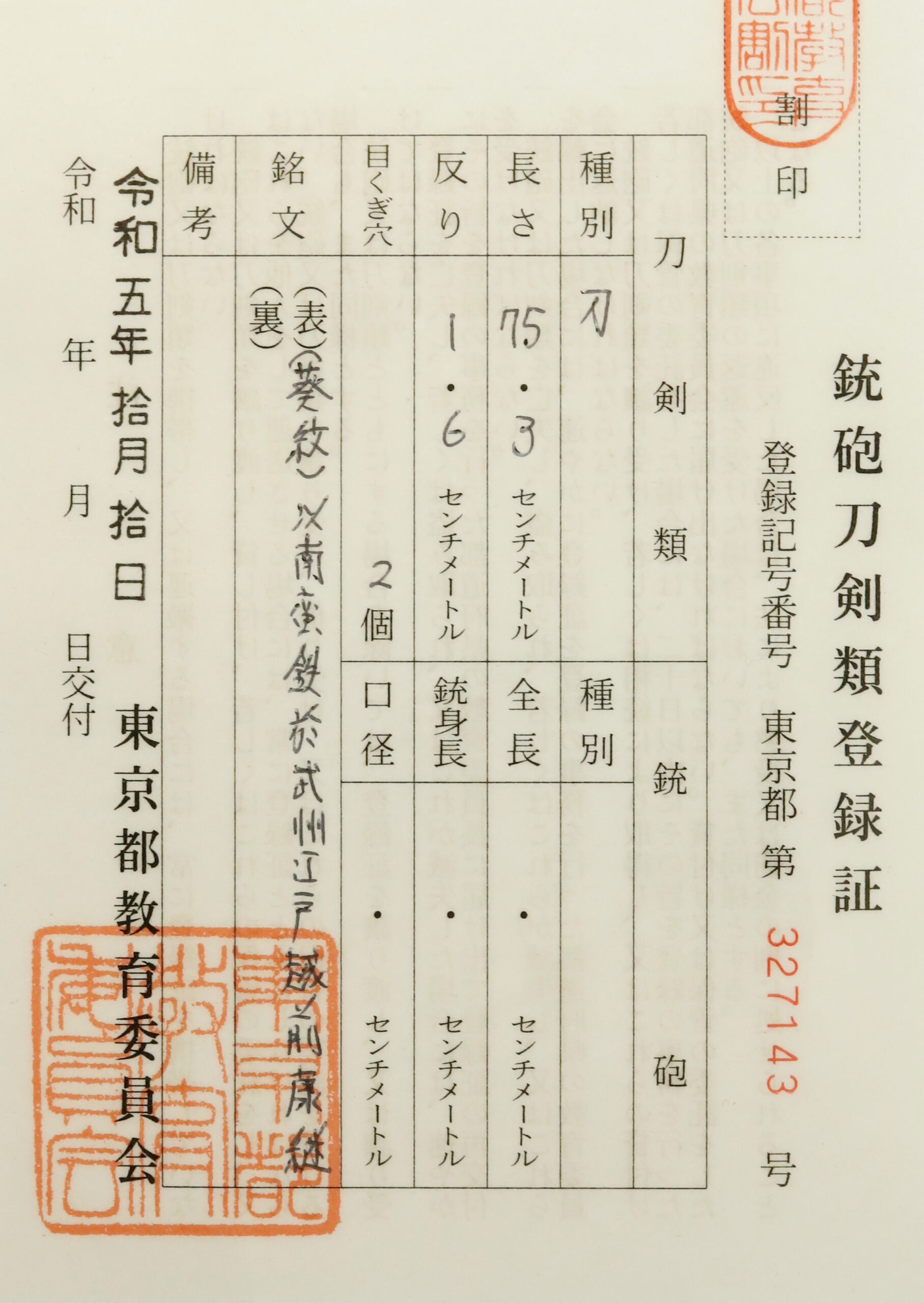
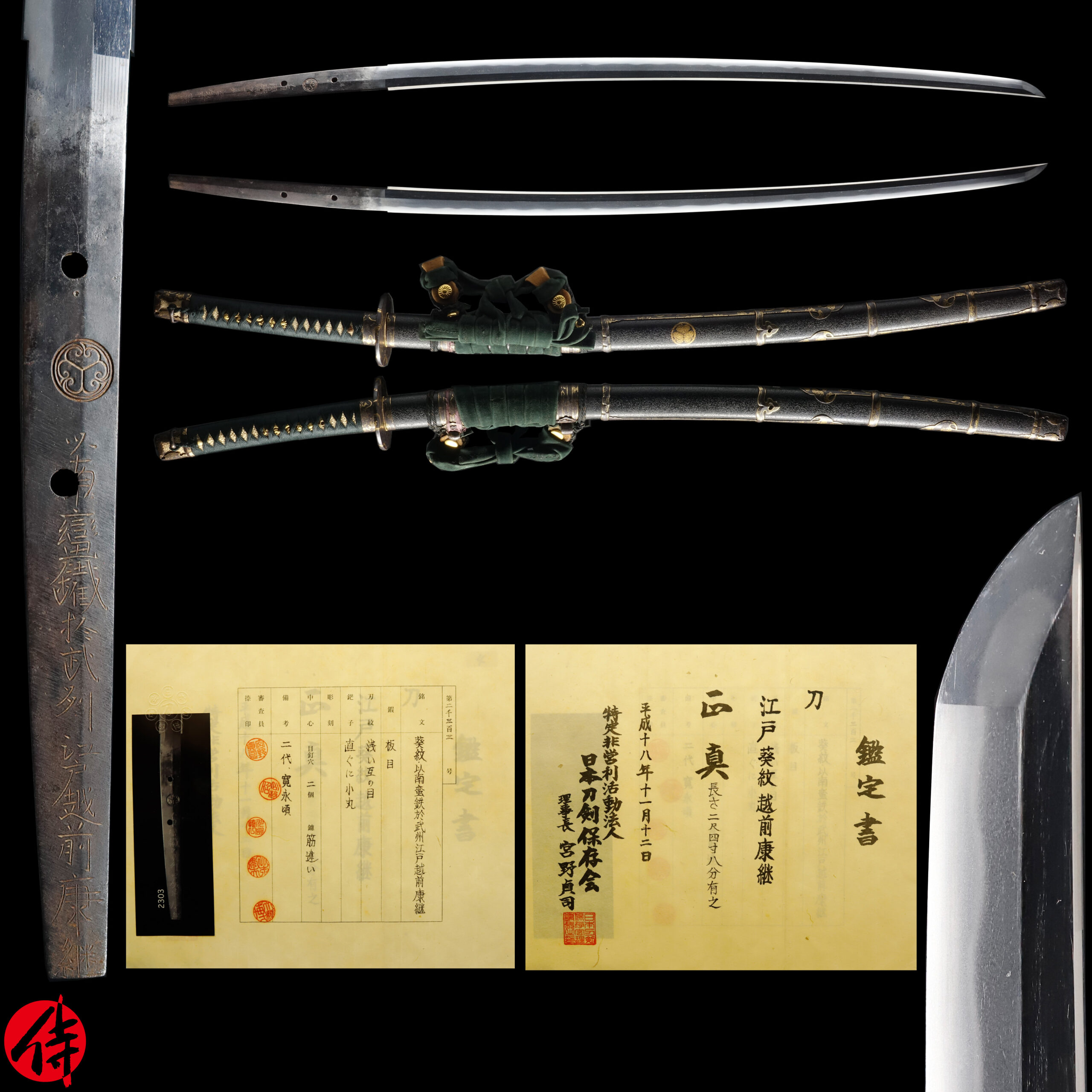
—————————————————————–
【About us】
Samurai Museum is located in Tokyo, Japan, exhibiting antique artifacts related to the Samurai history. Samurai Museum Shop is the place for those who are interested in Japanese culture and craftsmanship. We deal with antique Samurai swords/armor, traditional crafts made in Japan and so on.
【Japanese Sword& Export Process】
The Japanese swords we deal with are hand-forged edged swords made in Japan. It was made from the traditional carbon steel called TAMAHAGANE(玉鋼). Samurai Museum is familiar with the proper legal procedure for an antique/ authentic Japanese sword to be exported from Japan. We have sent more than 500 Japanese swords for the past three years (~2023) to amazing owners who appreciate its historical value.
Each Japanese sword is registered under the Agency for Cultural Affairs and the Board of Education in Japan. They issue a registration paper for each Japanese sword for its owner in Japan to legally possess it. The Japanese sword with its registration paper means it was traditionally hand-forged in Japan.
To legally export the sword from Japan to other countries, we will have to apply for its permit to the Agency for Cultural Affairs(Bunkacho) and return the original registration paper to the Board of Education. It normally takes around 2-4 weeks to receive this permit after submitting required documents. And we would like you to expect at least 1-1.5 months for your order to arrive at your given address after you ordered. For more detailed info, please click here.
It is allowed for residents in Japan to own authentic Japanese swords without a special license as long as they come with registration papers. Please feel free to contact us if you are a resident of Japan, whether temporarily or permanently. We will also assist you when you leave Japan and need to obtain the export permit.
【Payment Method】
We accept payment through Stripe (Credit card), PayPal, Apple Pay or ChromePay, all of which are secure payment methods. Also, you don’t need to make an account on Stripe for the checkout. If you prefer other payment method, please contact us. After confirming your payment, we will apply for an export permit. You may either pay in JPY, USD, AUD, CAD,EUR CHF or GBP. The price is set in Japanese Yen. Prices in other currencies are automatically calculated based on the latest exchange rate.

* If the amount is above 1 million JPY, Stripe or wire transfer will be the only options for payment.
【Shipping】
We have shipped authentic Japanese swords to the USA, UK, Canada, Mexico, Germany, France, Hong Kong and Australia. If you don’t live in these countries and like to order, please contact us first before making a purchase. We offer Free International Shipping as long as we can send antique Japanese swords by EMS.
We normally ship by EMS(Express Mail Service) provided by Japan Post. We will send you a tracking number for your order as soon as we hand it to the post office. We will put 100 % insurance on the shipping document without any extra charge. Based on the total amount, there might be a duty tax or other fee for you to pay, depending on the countries. We use package cushioning to protect the item and put it in a PVC pipe, which is one of the most secure packages because of its durability.
It will normally takes 5-14 days for the item to arrive at your given address after we dispatch it. Time of delivery is estimated as accurately as possible by the carrier but does not take into account any delays beyond our control such as by inclement weather, post office holiday seasons.
* If you live in Australia and like to purchase an authentic Japanese sword, please click here to know the detail.
*Please keep in mind that due to the spread of COVID-19, there might be delays in shipping. If you like to know the detail about shipping, please feel free to ask us.

【Review】
Here is one of the reviews we received from a customer who purchased an authentic Japanese sword from us. For more reviews, please click here.
“My experience overall with the whole process was wonderful. I had many questions about the history and process to purchase these treasures. All my questions were answered very timely and complete. The staff is very knowledgeable and very well versed if any questions do arise.”
【How to make sure the condition】
Please keep in mind that what you are going to purchase is an antique item. We uploaded high resolution photos for you to check its condition thoroughly. If you like to see more photos with different angles, please feel free to contact us. We will be happy to send them to you so that you can make informed decision. It is essential for us to know that you are happy with your choice of a sword. and we are prepared to use the best of our ability to serve you.
【How To Contact Us】
Please contact us through email, Facebook Messenger or Live Chat if you have any questions. You can find each icon on the right side of the website. Please click one of them to reach us. We will reply to you within 1-2 business days.
【The Art of Nihonto (Japanese Sword)】
Samurai’s history is a profound, eloquent legacy of ancient Japanese warriors in which millions of people worldwide are being fascinated. If you like to find out the art of Nihonto, please click here.
【A Guide to Japanese Sword Maintenance】
After acquiring an genuine Japanese sword, it is also important to know how to take good care of it. Here is the special video for you. Mr. Paul Martin, Japanese sword expert, shows you how to give proper maintenance to your sword. By mastering how to clean the Japanese sword, its aesthetic beauty will last forever.
When you purchase a Japanese sword from us, you can get a Free Japanese sword maintenance kit. It comes with four tools(Choji Oil, Uchiko Whetstone Powder, Peg remover, Oil Applicator). By watching the video instruction above , you can enjoy learning how to maintain your Japanese sword while appreciating it. If you have any difficulty assembling the sword or cleaning the blade, you can feel free to contact us.


MORE ANTIQUE JAPANESE SWORD FOR SALE
SWORDS WITHOUT CERTIFICATES FOR SALE
LEARN JAPANESE SWORD TERMINOLOGY
Thank you for reading all the information on the page. If you have any difficulty choosing the right Japanese sword for you, we will be more than happy to help you find the one that speaks to you the most. Please feel free to contact us.
